
Close the corporations! Sequester the supermarkets! Emotions can run high once you visit Brooklands, one of the most imposing and impressive pieces in the jigsaw of automotive history. One visit to the track is all it takes to fall completely under its spell; several trips in and you’ll be a convert to the cause. This is not a call for wanton destruction, I want to make clear. It’s just that I would really, really like to see the impossible: Brooklands oval restored to its full glory. And the companies who now inhabit the sprawling Brooklands industrial site are… kind of in the way. It’s nothing personal. I have the same reaction to most historic ruins, whether race-track, castle or house. Don’t get me started on the total destruction of Rouen-les-Essarts in Northern France, for instance. But there’s a joy when you see a track saved.
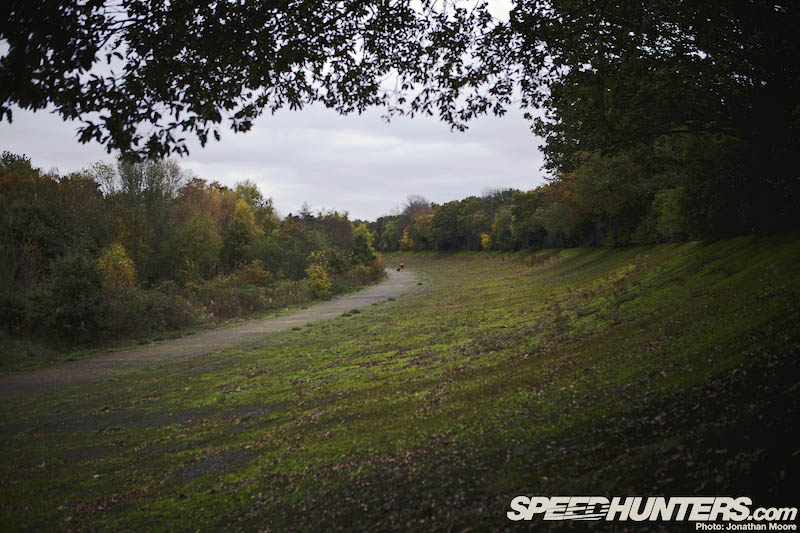
A day spent investigating the sprawling Brooklands site shows just how much of the grand old oval survives – and makes it all to easy to daydream of the massive track in full operation. As long as you don’t look at the crumbling surface too closely, that is…
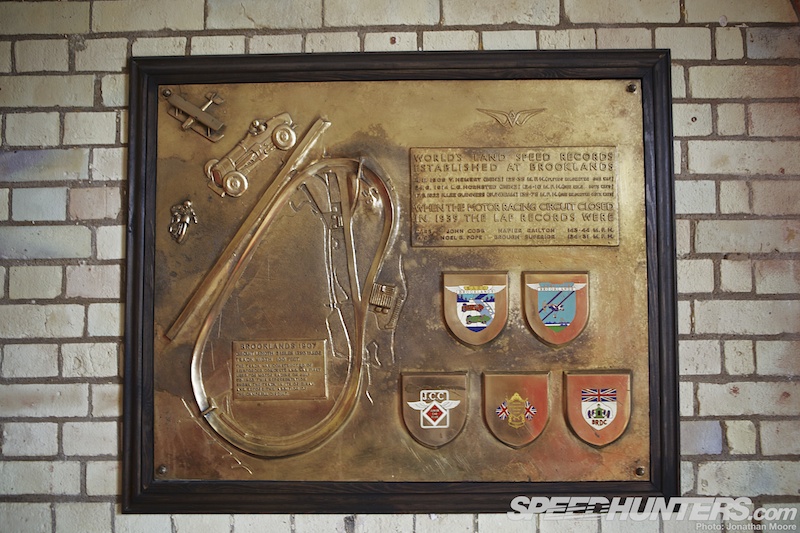
Like the Monza, Montlhéry and Indianapolis ovals from the same period, Brooklands played a key role in the evolution of motor racing at the beginning of the 20th century. Indianapolis has grown into the biggest auto racing venue in the world; Monza’s banking lies dormant but intact; Montlhéry sits behind locked gates. Brooklands was almost lost to the world in the 1960s, but thankfully a combination of a passionate public, last-minute government intervention and a little bit of modern-day auto manufacturer fairy dust have revitalised the site, freeze-framing a tantalising view of a most glorious period of racing.
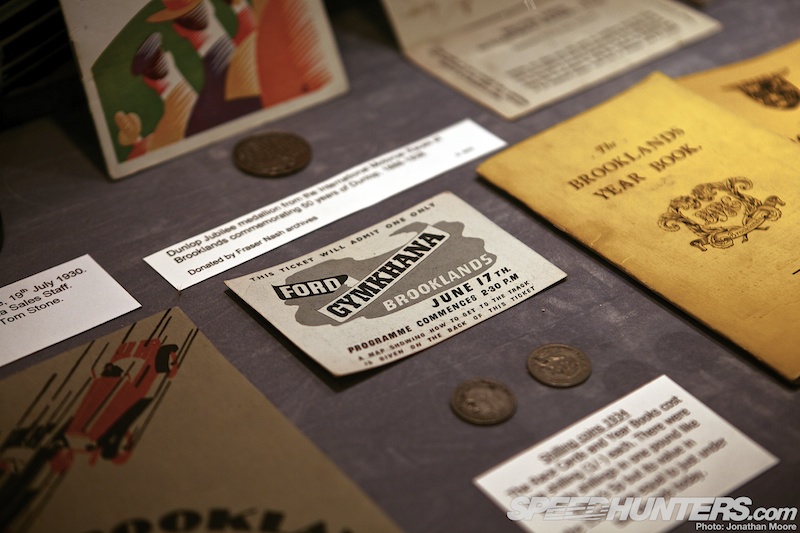
Brooklands is where organised, professional racing in the UK was born. Over 100 years ago, in a small, leafy village on the outskirts of London this vast 2.8-mile oval was constructed: the first ever purpose-built racing track in the world. For 32 years, between 1907 and ’39, Brooklands was the crucible for a grand celebration of all things motorised. Endurance racing, sprinting, bike racing, period Time Attack, rallying, gymkhana: they all took place at Brooklands. In 1905, wealthy landowner Hugh Locke King and his wife Ethel had travelled to the Coppa Florio road-race in Italy, and were aghast at the fact that there were no British entrants. There was a good reason for this: speed limits in England were set to just 20mph and organised competition was banned on public roads (a law that is only now due to be rescinded). Locke King had recently inherited the large Brooklands estate in Weybridge, Surrey, to the south-west of London.
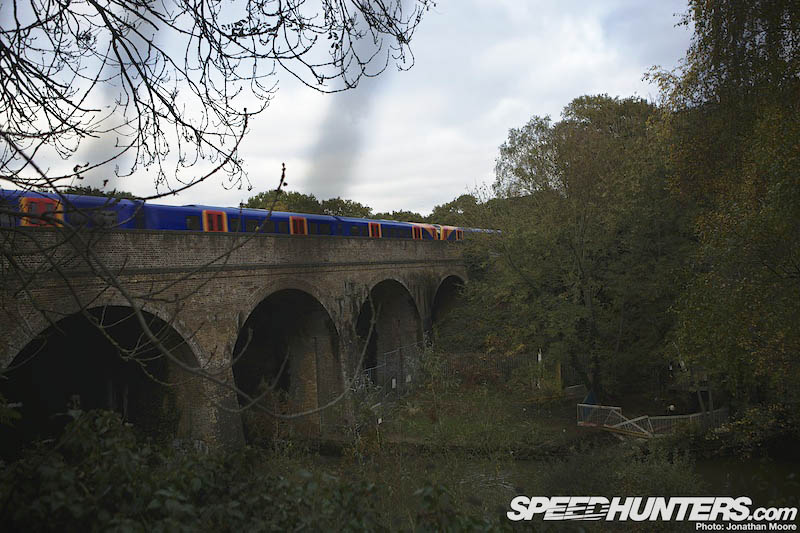
The mainline railway ran past the estate (it still does, as seen here with a train crossing the river bridge that runs parallel with the track’s Railway Straight), and although the marshy ground was bisected by the River Wey it was the ideal location for his ground-breaking plan: to build a dedicated venue for this new sport.
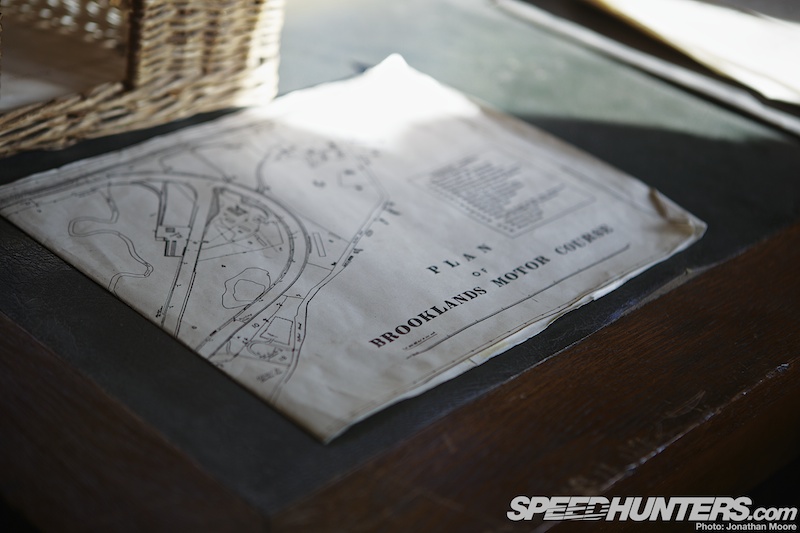
Brooklands was originally planned as a flat oval, but early in the project that was changed by the track’s designer, a Colonel Holden of the Royal Engineers, to be a huge, banked monster which would allow even greater speeds and daring. 1,500 labourers toiled away from the Autumn of 1906 to create the banking and pour the enormous quantity of concrete – six inches were laid across the track’s 100 foot-wide surface. The River Wey was bridged using new techniques that were able to support the weight of the banking above. The cost was frightening, and Locke King’s wife had to bail out the build to complete construction.
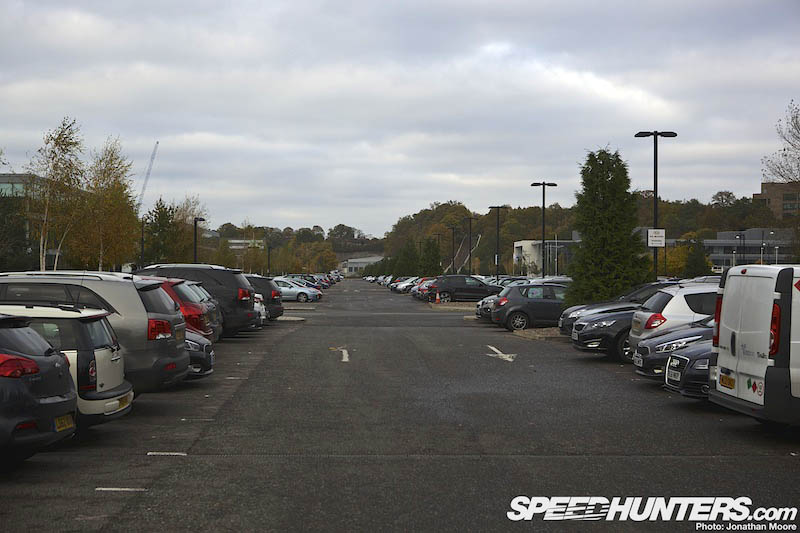
But in only nine months the 2.8-mile track was ready: and not just the outline oval itself. A dedicated half-mile start/finish straight bisected the north-east corner of the track (the majority of the straight is now covered over with parking for the surrounding business units).
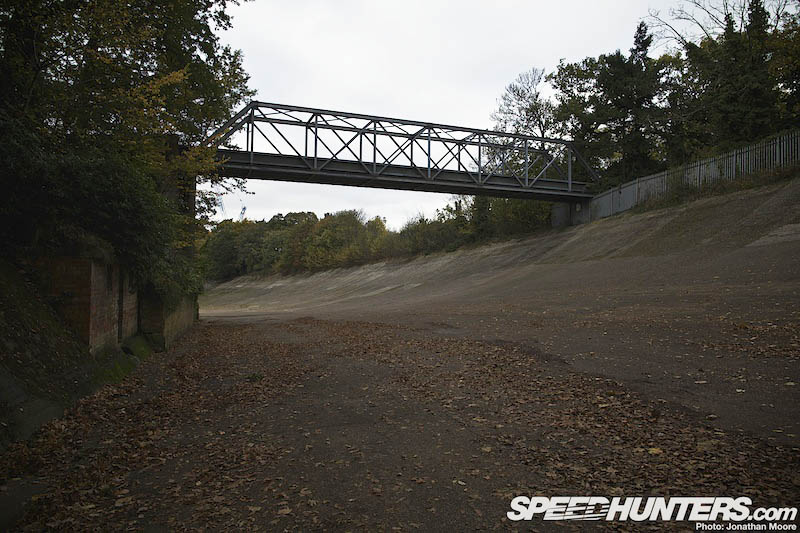
This was a fully functioning facility, with restaurants, grandstands and bridges providing easy access for a possible 287,000 spectators from the road, railway and river.
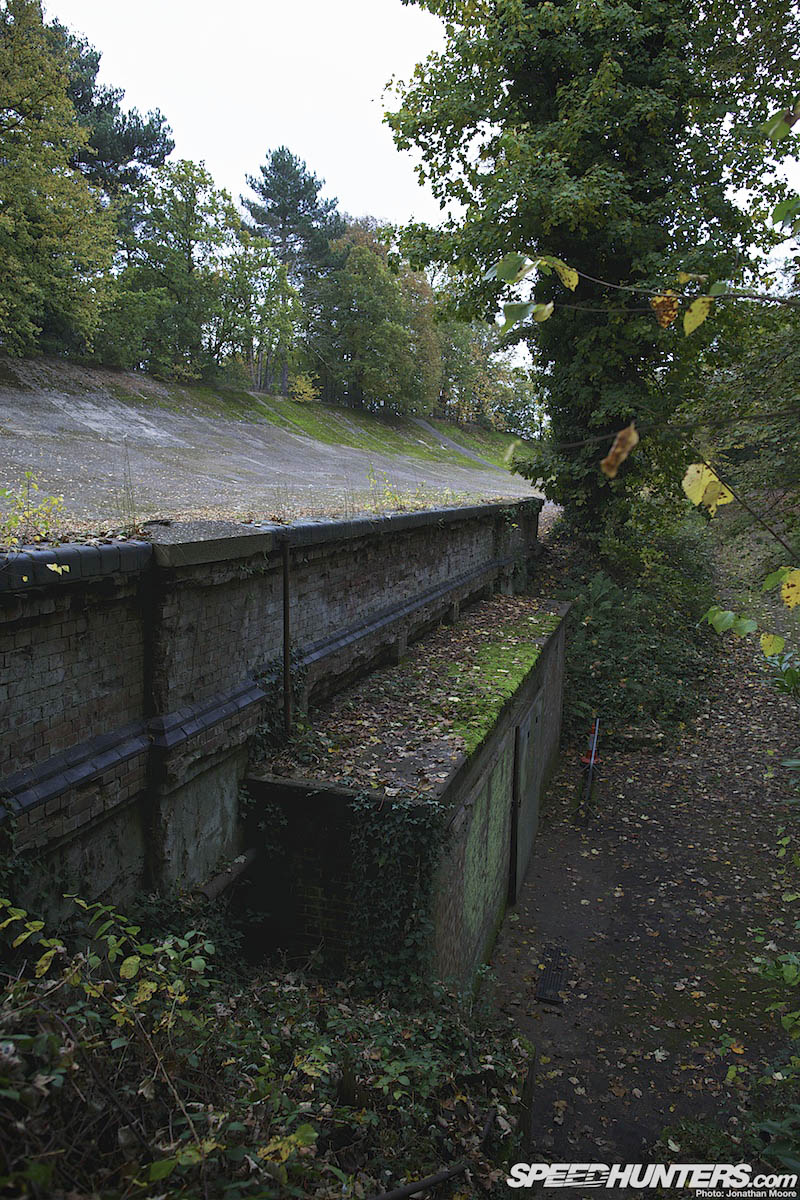
A tunnel also ran underneath the Members Banking, further improving access. It’s a feat that even track builders today struggle to match.
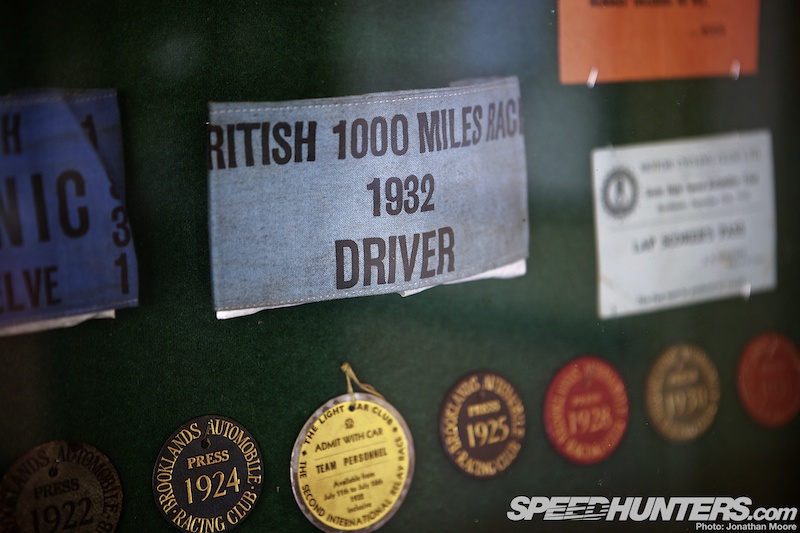
Brooklands opened on 17 June 1907. Locke King and his wife led a parade of cars around the awe-inspiring, vast expanse of the oval; an impromptu race broke out as cars began to vie with each other to see who was fastest. It’s just the thing that car people do: they always have and always will.
The track must have utterly shocked those who attended: a man-made, giant amphitheatre dedicated to the spectacle of the motor car.
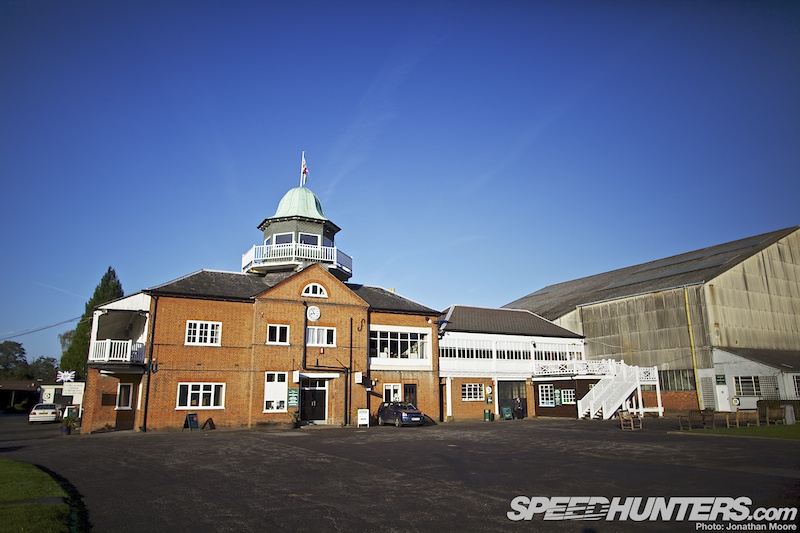
Just imagine the vast open space enclosed by the ribbon of concrete, a small cluster of buildings (including the clubhouse, which still stands, though now surrounded by hangars and other buildings) dwarfed by the sheer scale of the oval.
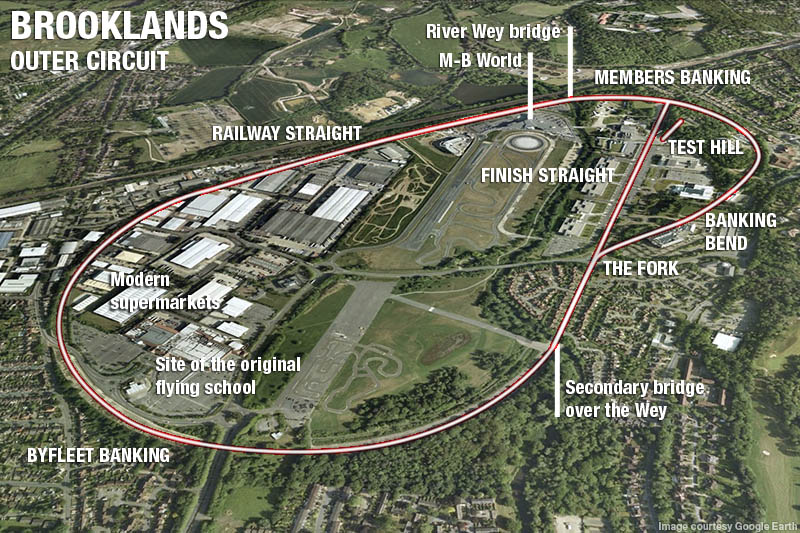
Two mighty arcs of banking sat at either end of the circuit: the extreme Home – now more commonly known as Members – Banking to the north and the lower, shallower Byfleet Banking at the southern end. The Railway Straight joined the two sections of banking on its western side, and an indented curving return provided both a link to the east and the lead-in to the start-finish short-cut. The banking was 30-feet high in places, and at the eastern approach to the Members Banking competitors were faced by a seemingly vertical rise as the track lifted and twisted to the left at Banking Bend, up the side of the ridge-line.
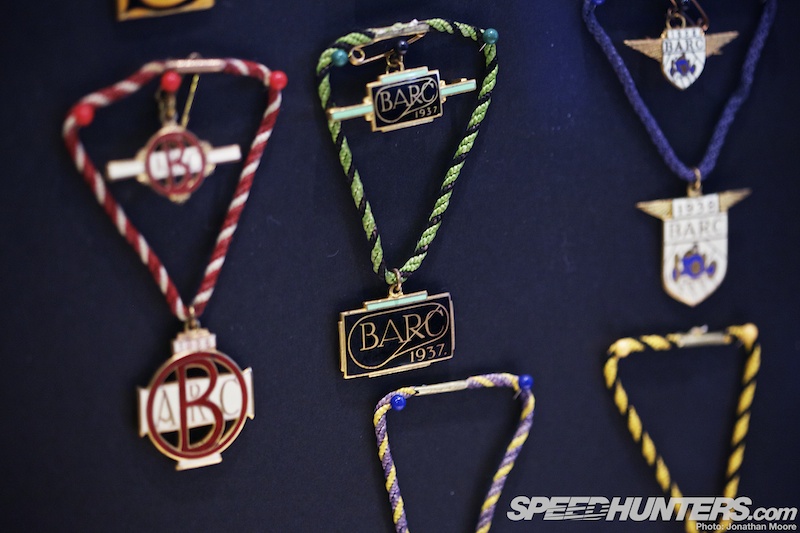
Almost immediately the track gained other uses: automotive testing, time trials, speed and distance record attempts were all held at Brooklands. Just two weeks after the grand opening, British marque Napier ran three 60hp cars around the track for 24 hours – one driven solo – with red lanterns around the track’s perimeter and flares marking the top of the banking, completing the day-long marathon at an average speed of 65mph.
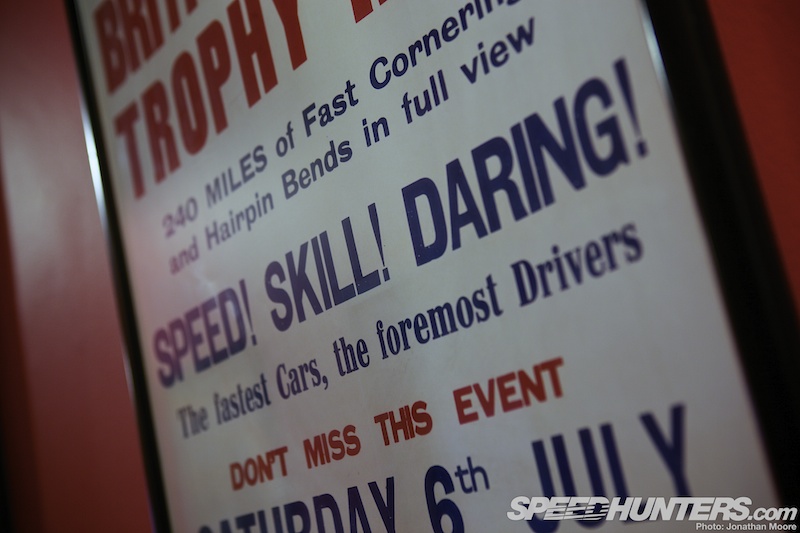
The engine noise during the night enraged local residents, and their complaints prevented further overnight races from taking place. But the achievement stunned the general public: it was equivalent to the impact that the Veyron and Koenigsegg speeds have nowadays. The Napier team had averaged three times the legal speed limit for 24 hours.
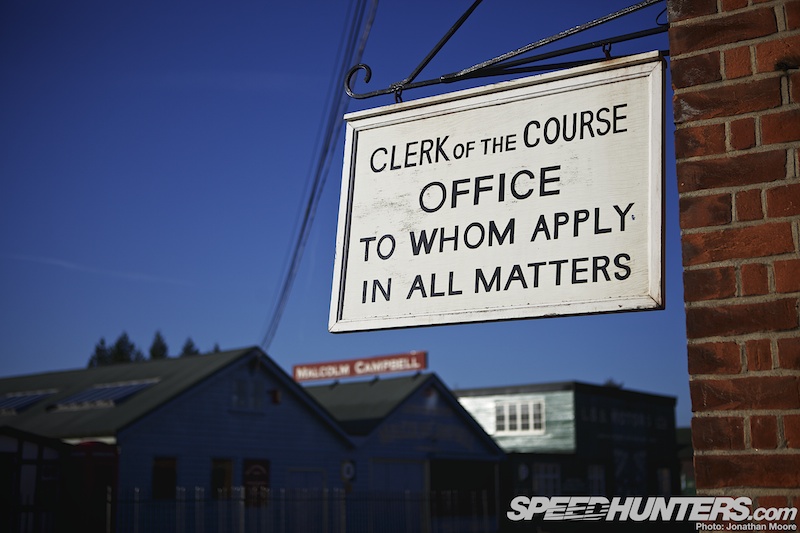
The first race proper was held a week later, and with no regulatory body in place horse-racing rules were used, complete with drivers wearing jockey-style silks as identification (and a ban of female drivers, despite the high interest). It wasn’t a success: the hugely wide and long track meant spectators had no chance of identifying cars.
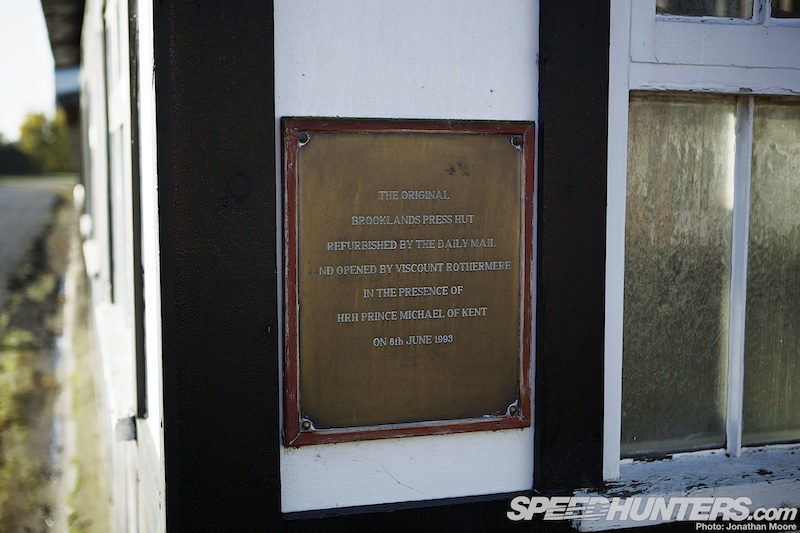
But racing is always about innovation, and rules were quickly developed to cater not only for the drivers but also to balance hugely disproportionate performance between the cars of the time. An electronic timing system was developed and used in combination with a card database of driver results to manage a handicap system; numbers were painted onto cars and the Speedhunting press of the time allowed in to cover the action in close-up.
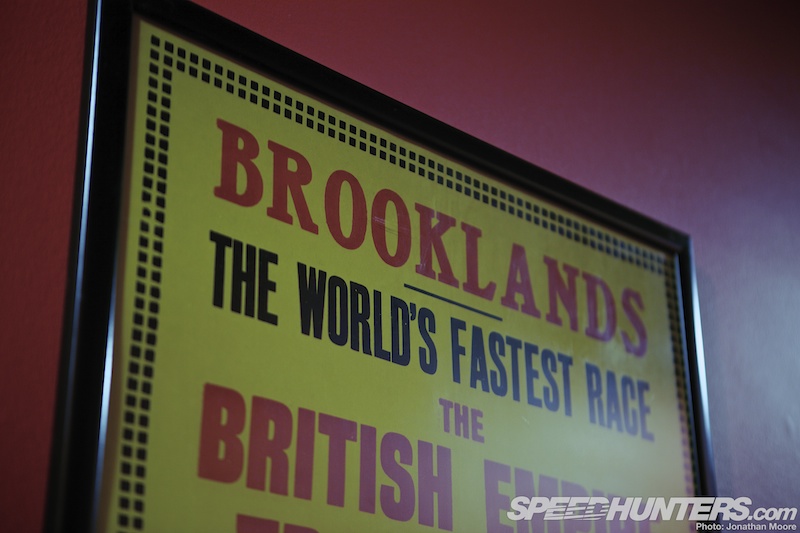
Races were no touring car sprints: distances were often two or three hundred miles over hundreds of laps, NASCAR style. The long Railway Straight was often used for straight-line speed runs, and velocities quickly climbed over 125mph for a measured kilometre.
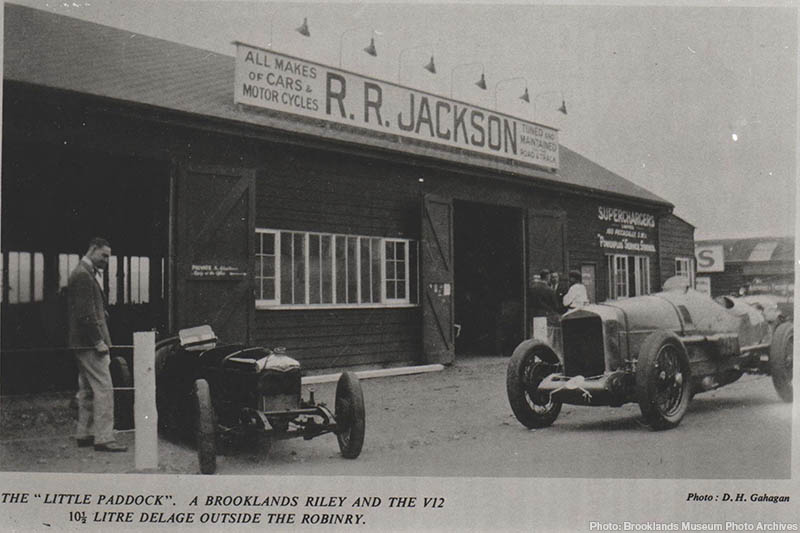
Motorbikes were also very popular at the track, as a more affordable option to the expense of developing a racing car, and bike racing kicked off in 1908. Teams opened up workshops on-site in the heart of the track.
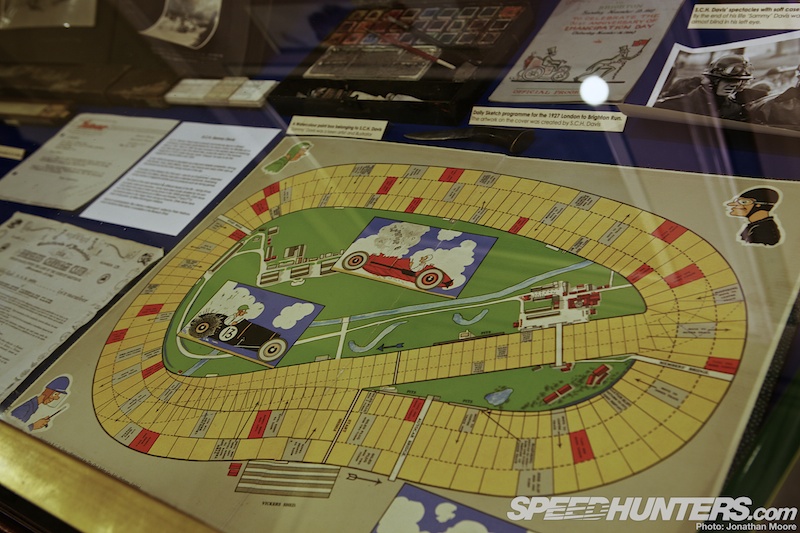
Brooklands had arrived in the national consciousness and continued to be the place associated with racing for many decades. Books, games, radio plays: the thrill of racing was pulsing through the British public.
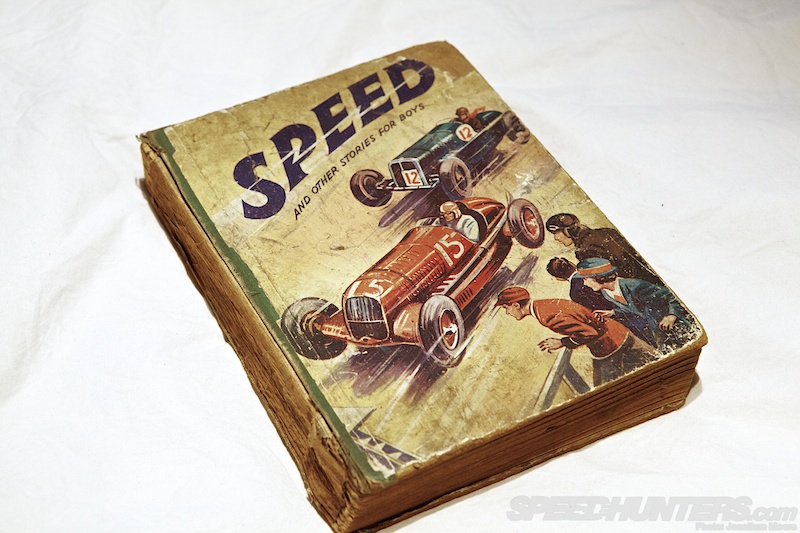
I was recently given a children’s illustrated book from the 1930s, and as its headline story was Speed: the epic Brooklands battle between hero Tony Vargas in his MG and the dastardly ‘Speed’ Barling’s Italia.
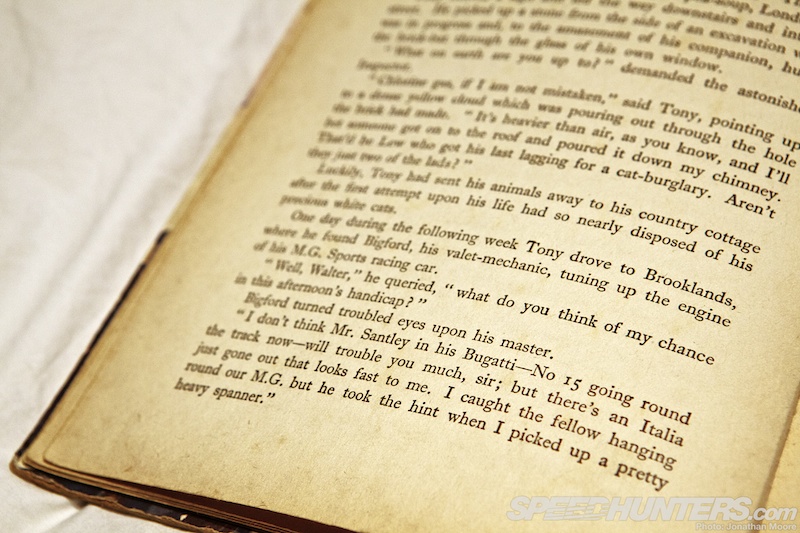
Naturally, Our Man overcomes his nemesis, beating him on the track and putting an end to his evil deeds…
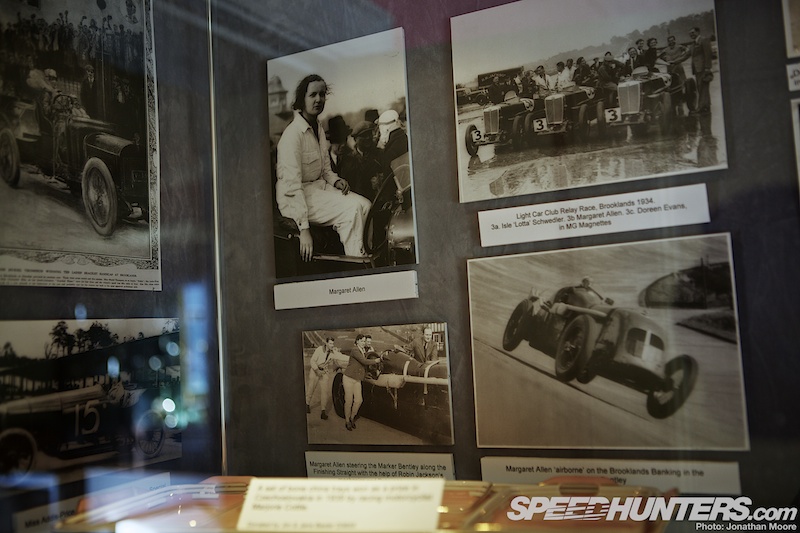
Alongside racing, Brooklands was also the centre for the nascent British aero industry: in 1909 a flying school and grass airstrip were opened at the south end of the track and they became the place in London to learn to fly. At a time of an increasingly vocal fight for equality, Brooklands also attracted plenty of women: famous pilots such as Amy Johnson headed the list of women flyers, backing up ever increasing large numbers of female race-drivers at Brooklands post-WWI. Special races were put on for ladies-only grids, but women competed in and won mixed races.
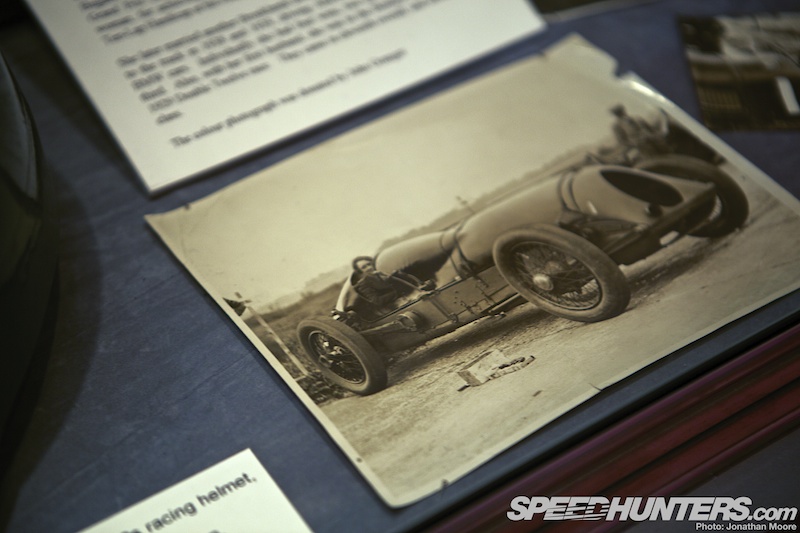
Joan Chetwind held the 12-hour speed record in the ’20s, for instance, and Elsie Wisrom won regularly in the ’30s – much to the chagrin of the male-dominated establishment. Jill Scott, pictured here in her enormous Leyland-8, was one of several ladies driving the most powerful cars of the time.
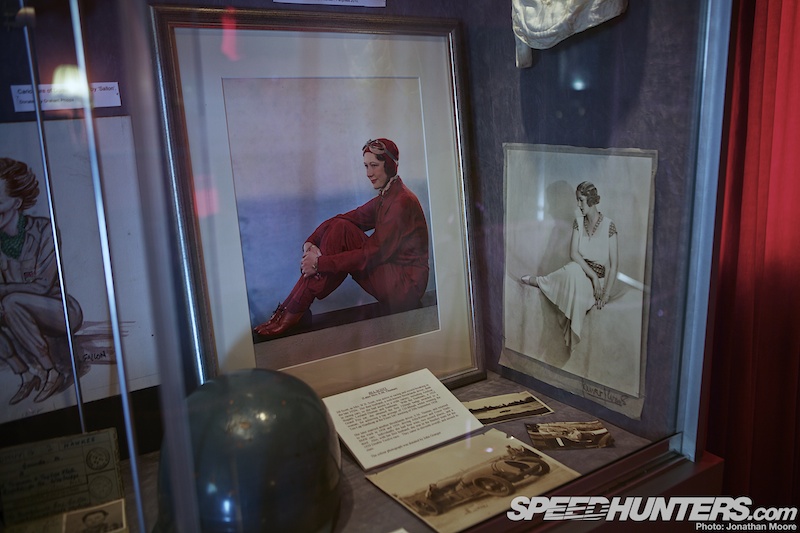
The Clubhouse and Members Hill gave it a social aspect – London’s fashionable high society gathered at the track, and the famous novelist Barbara Cartland was a regular visitor to the track as a period gossip columnist. The modern Goodwood Revival deliberately aims to be its spiritual descent, having appropriating the Brooklands slogan of ‘The Right Crowd And No Crowding’.
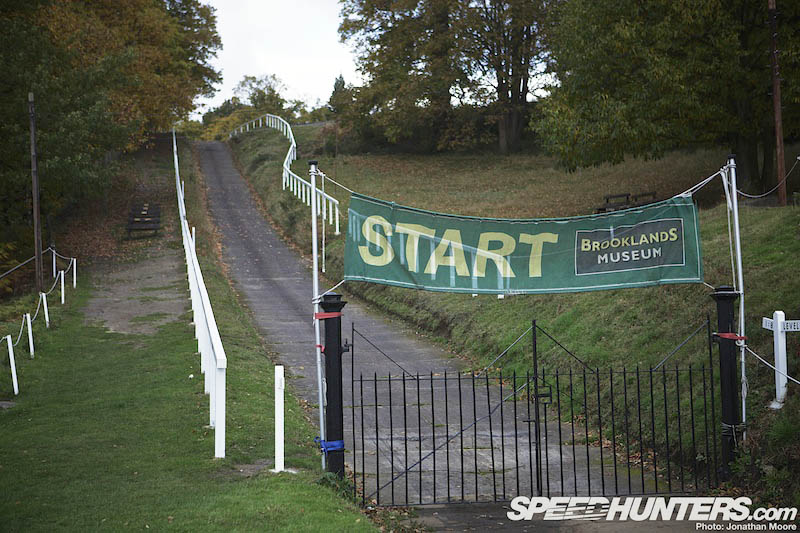
1909 also saw the creation of the Test Hill running up the side of the Members Hill: 352 feet long and divided into three sections, the hill starts with a gradient of 1-in-8, then 1-in-5 and then a final steep section of 1-in-4. Cars running up the hill were famous for launching at the crest, one even noted to have landed in the factory building constructed at the top, a good 50 feet away. Bikes often parted from their riders.
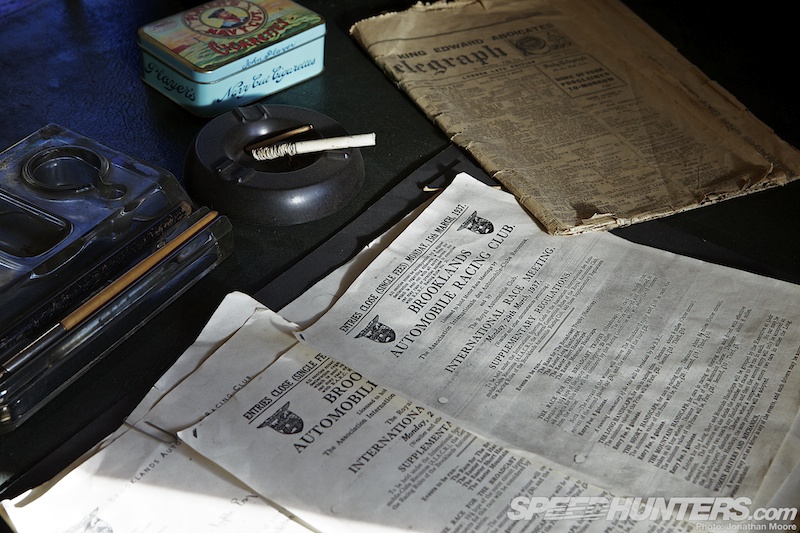
Year after year new records and standards were set at Brooklands. Speeds rose, distances covered rocketed. The cars and bikes just got faster and faster as cutting edge technology was applied to this new and exciting sport, held in a perfect, dedicated location.
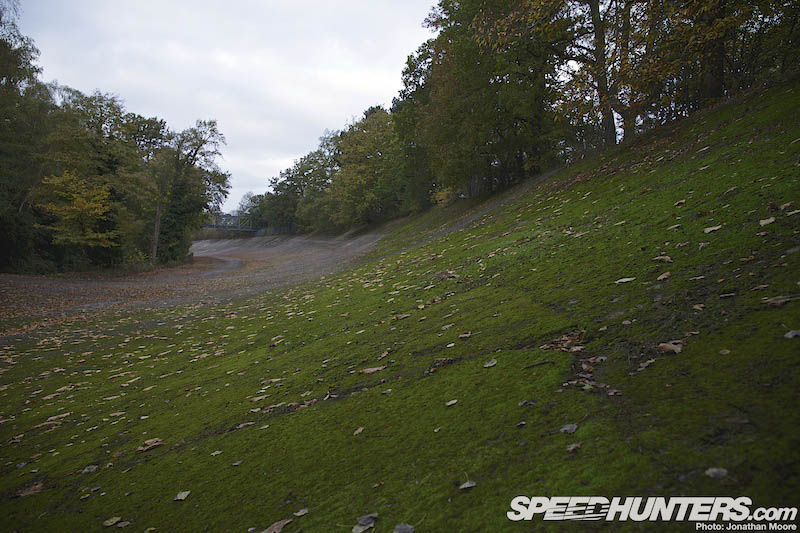
Along the centre of the banking a line was originally painted, above which cars would theoretically take the curves without requiring any steering input. However, taking your hands off the wheel at Brooklands was not recommended if you were interested in having a long lifespan. Death came hand in hand with racing here, as it would for racing in general for the next 60 years. Brooklands’ first fatality came early — at only its second meeting. It would be far from the last casualty the track would claim. The speeds achievable on the oval had been utterly inconceivable up till then, and technology had to rapidly evolve to keep cars on the ground and drivers out of it.
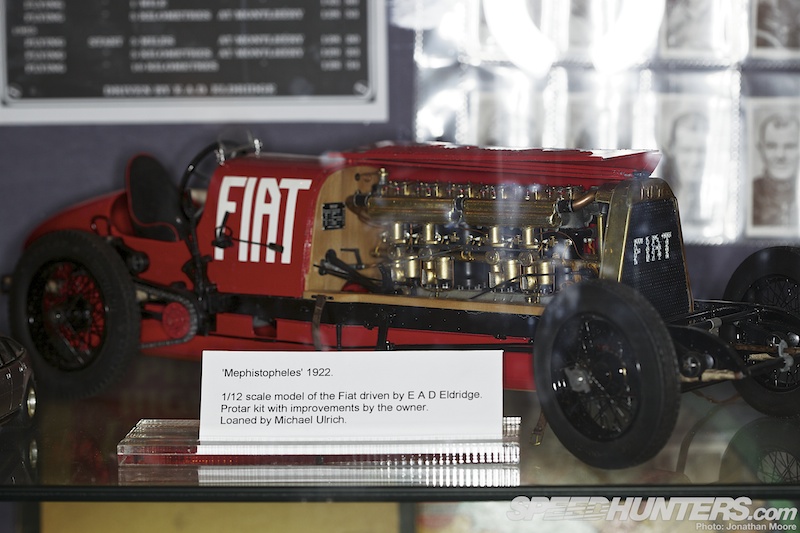
The horror of the First World War interrupted racing at Brooklands for six years: the Royal Flying Corps took over the site, and seeds were sewn for the eventual final use for Brooklands: aviation. Wartime damage (from lorries rather than bombs) meant the track didn’t reopen until 1920: Malcolm Campbell, who would go on to world fame as a land- and water-speed record holder, won both races. Even more extreme cars emerged. Chitty-Chitty Bang-Bang (yes, the film was based on the name of real cars) was the unholy result of mating the 23-litre aero engine from a WWI Gotha bomber to a Mercedes chassis; ‘The Viper’ was a V8 Hispano-Suiza aero engine in a Napier; Mephistopheles was a FIAT fitted with a 21.7 litre aero engine. You can see the basic trend.
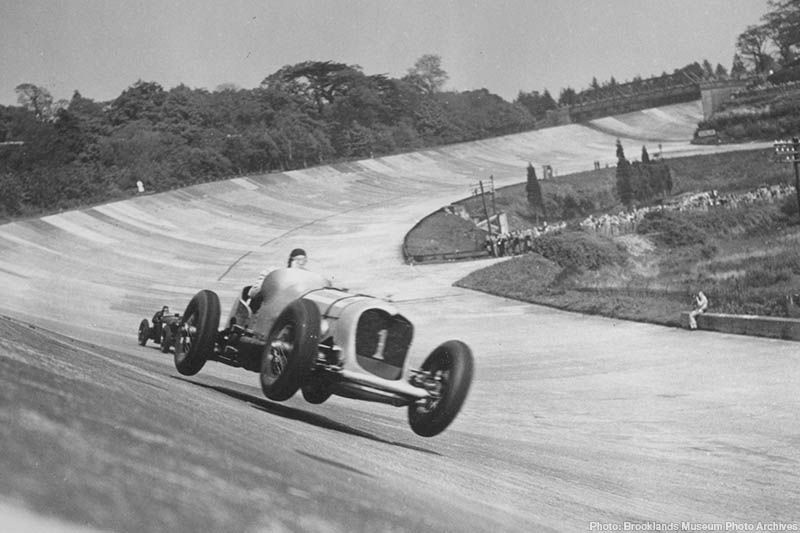
But a problem from the very start was the nature of the track itself: made from concrete slabs laid on sand with expansion joints, the surface easily broke up and required extensive, expensive repairs over each winter. Where the huge swoop of the Members Banking crossed the River Wey the track had begun to sag alarmingly, creating a dangerous bump that caught out cars and bikes alike. Four-wheelers became two wheelers; two-wheelers became one-wheelers. One-wheelers became crashes.
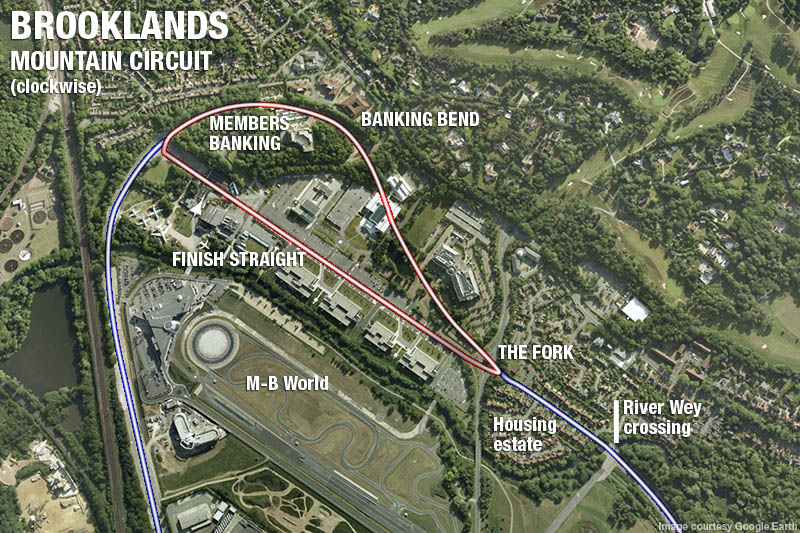
New layouts were constructed to supplement the big oval Outer Circuit: the Mountain Circuit ran clockwise up the start/finish straight…
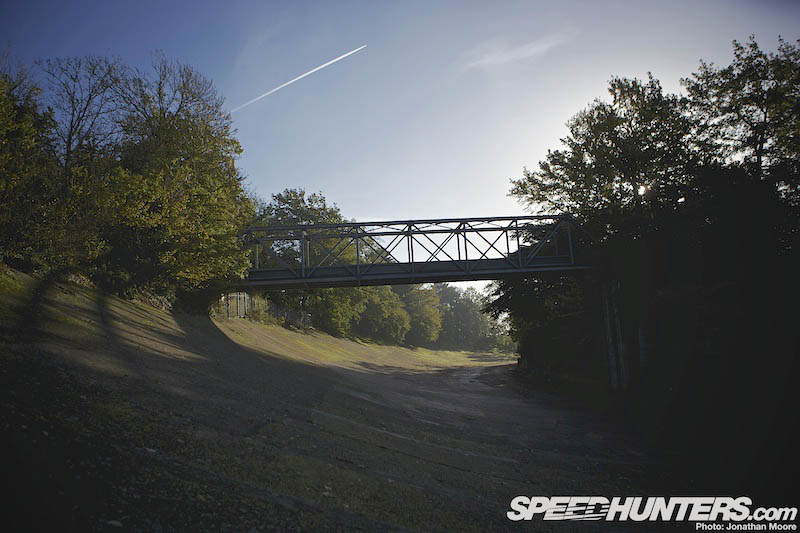
…to meet the Members Banking but then turned right in the opposite direction to normal travel, travelled around the banking underneath the bridge, plunged downhill to a hairpin at The Fork (adjacent to the sprawling Vickers-Armstrong aircraft factory) and then came back up the straight.
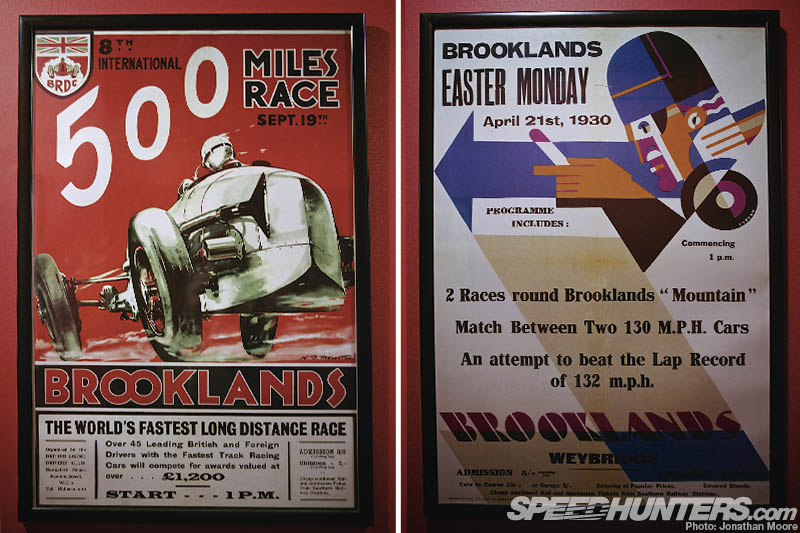
Grand Prix racing was introduced to Brooklands in 1926, using a new infield course created to rival the more complex layouts in use on the Continent. This first stab involved cutting off the section of banking between The Fork and the Members Banking and instead using the Start Straight on a permanent basis, inserting two temporary chicanes at the top end. This layout was also used in reverse, without the chicanes, from time to time. Bentley’s success in the 24 Hours Of Le Mans rekindled excitement for endurance racing, and twin 12-hour races with an overnight break (the famous Double-12 events), 500 mile and 1,000km events were held from 1929.

This was also the period when iconic cars like the Napier-Railton competed: a 560hp, W12, 24-litre behemoth. These cars still competed in mixed-class races, where the handicapping system system in longer races meant the small voiturettes might start an hour or more ahead of the big aero-engined cars! An alternative was the setting up of different chicanes and obstacles at The Fork for the various classes of car to negotiate.

Think track days are a new thing? Think again. Brooklands hosted open pit-lane days from early in its life, and during the week the track was buzzing with public participants as much as any modern circuit today. Until the opening of Britain’s other permanent circuits in the ’30s, Donington Park and Crystal Palace, Brooklands remained the home of both motorsport in general and the British Grand Prix in particular in the UK.
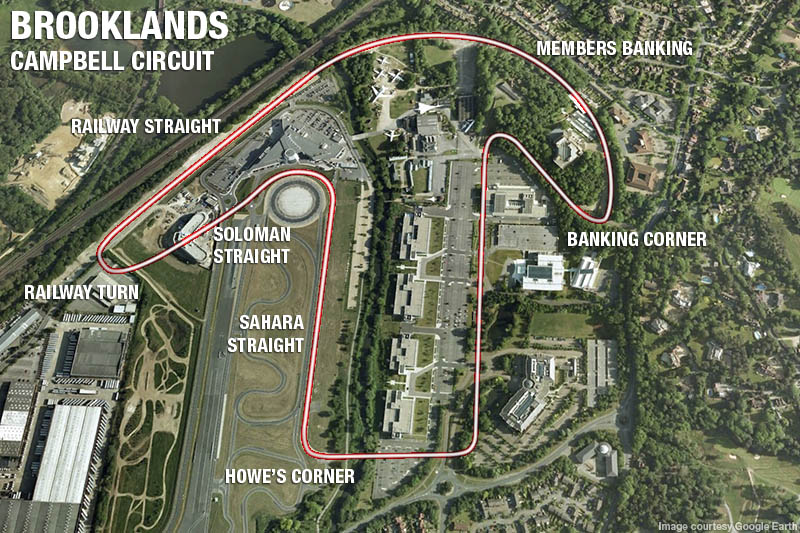
In 1936 Ethel Locke King, now a widower, sold her shares to a company whose directors included Malcolm Campbell. Under their stewardship another new section of track was created: the 2.3-mile infield Campbell Circuit. 

The uphill corkscrew right by the Test Hill and rising straight that leads up to Banking Corner are still extant, and used as an entrance to the Museum site.

The Campbell Circuit would have arrived from the left in this shot, running parallel with the main, full-width finish straight where all the cars are parked. Alongside all the other layouts and activities, the ’30s were a glorious period at Brooklands. Only one thing would derail it: the onslaught of the Second World War. The track was once again requisitioned, and this time the entire site was given over to aircraft production. Hawker Hurricane fighters and Wellington bombers poured off the production lines, the planes pushed down the track from the hangars to the interior airfield.
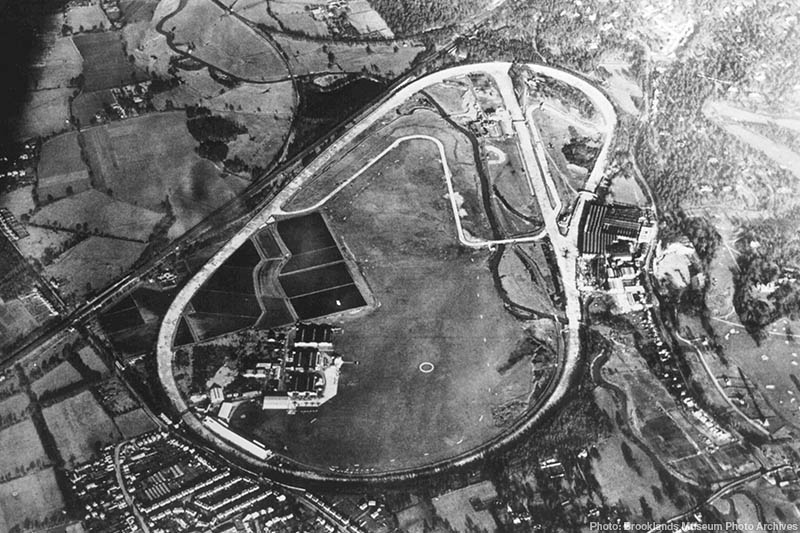
Of course, the huge Brooklands track provided one inherent drawback to being the centre for wartime production: the gleaming concrete oval would provide the perfect aiming reticle for enemy bombers. A major camouflaging project was undertaken to try and disguise the area: the track was covered over, swathes of track cut through to improve access to the factories and the main bridge over the Wey demolished.
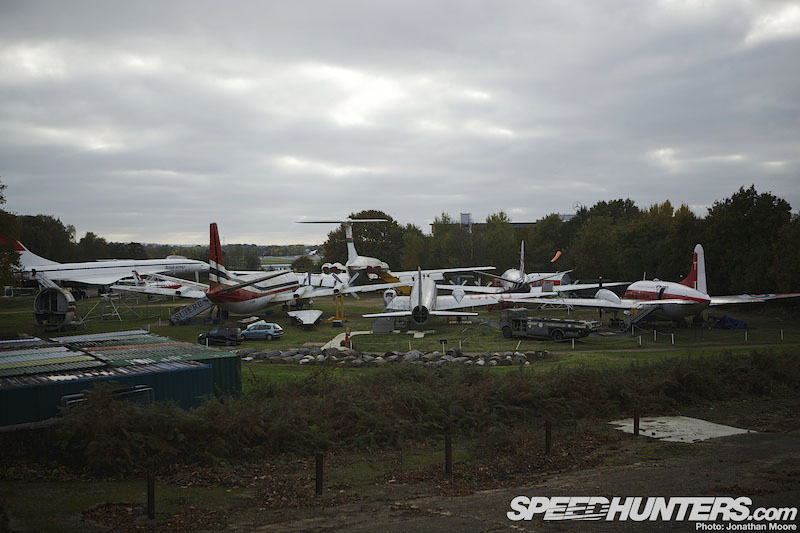
It spelt the end for racing at the track: the damage from both the factories and bombing meant that repairs would be prohibitively costly and in 1948 the Vickers aero company took over the entire site. The spirit of innovation continued though: a number of high-tech civilian and military aircraft were developed at Brooklands, including Concorde, and many of these are now displayed within the Brooklands Museum area.
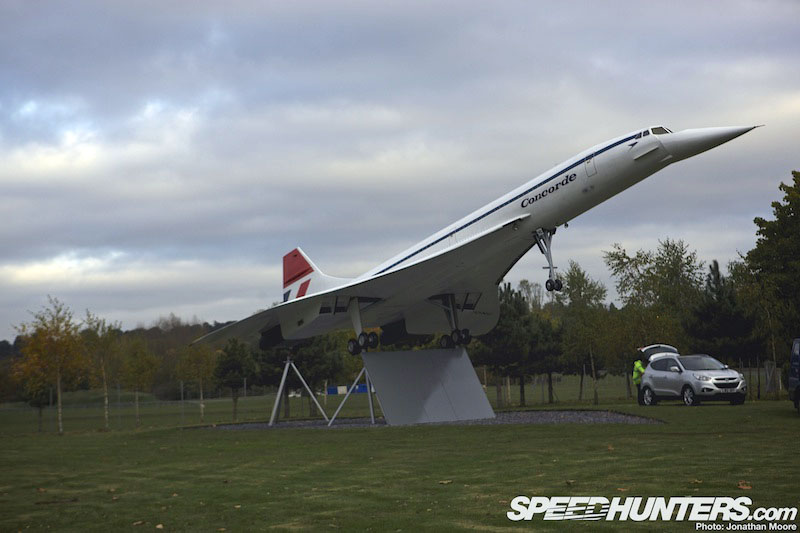
Concorde itself is celebrated with this model at the entrance to the Mercedes-Benz World complex – it was originally a gate guardian at London’s Heathrow airport.

With the infield torn up and the outer oval eviscerated in part, the racing track looked like it would quickly disappear under the progress of industry. But on the track’s 50th anniversary in the mid-’60s the editor of the famous Motorsport magazine, William Boddy, created the Brooklands Society, dedicated to preserving what remained of this most important part of global motorsport heritage.
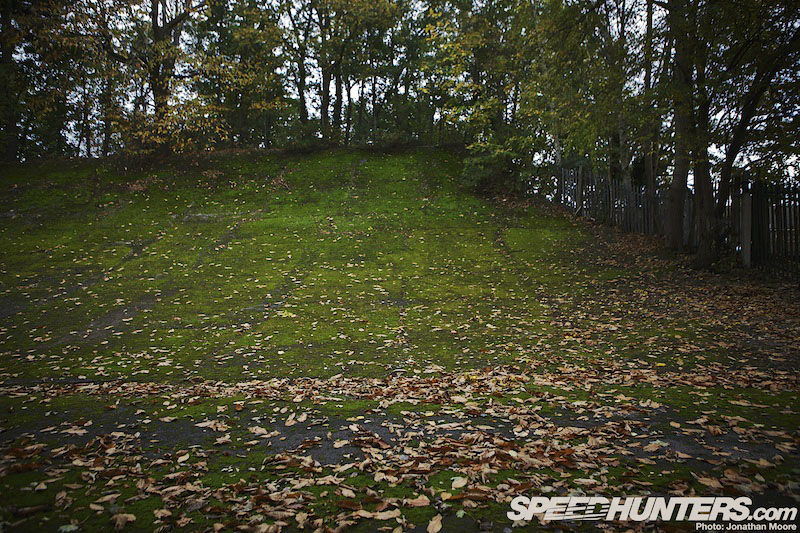
As more and more of the land was sold to developers, the oncoming tide was stemmed with the lease of 30 acres of the site to the society, a plot that included a section of the majestic Members Banking and most of the remaining club buildings. At its northernmost tip the banking is cut clean through, just before it would have reached its high-point along the ridge overlooking the site. This is the section that most visitors see: the protected, accessible stretch of unfeasibly wide and high banking.
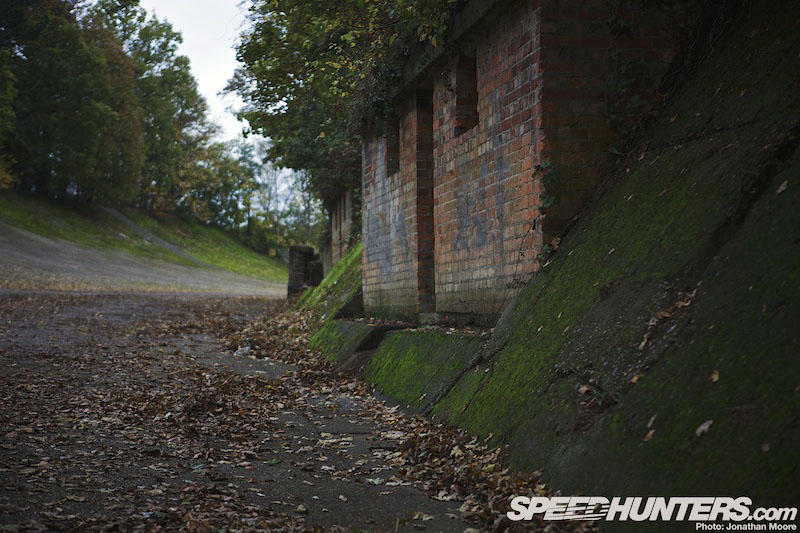
Turning to the left and following the track round in the direction that the cars would have taken, you pass small brick bunkers built during WWII: ammunition stores for the anti-aircraft towers that were mounted on the high ground above.
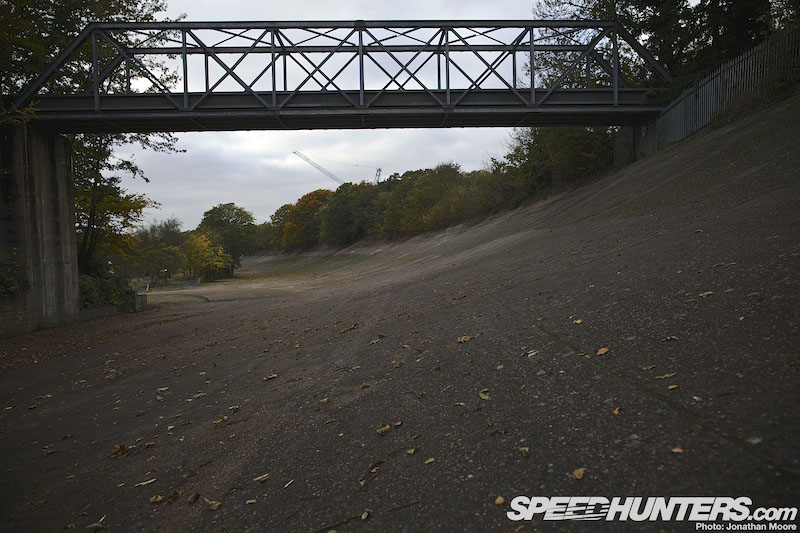
Carrying on round you come to the most iconic part of the track where the restored Members Bridge crosses overhead. The track rises up dramatically to its high-point, the gradient increasing exponentially as it goes, until it reaches a degree that is virtually insurmountable without crawling up on your hands and knees.
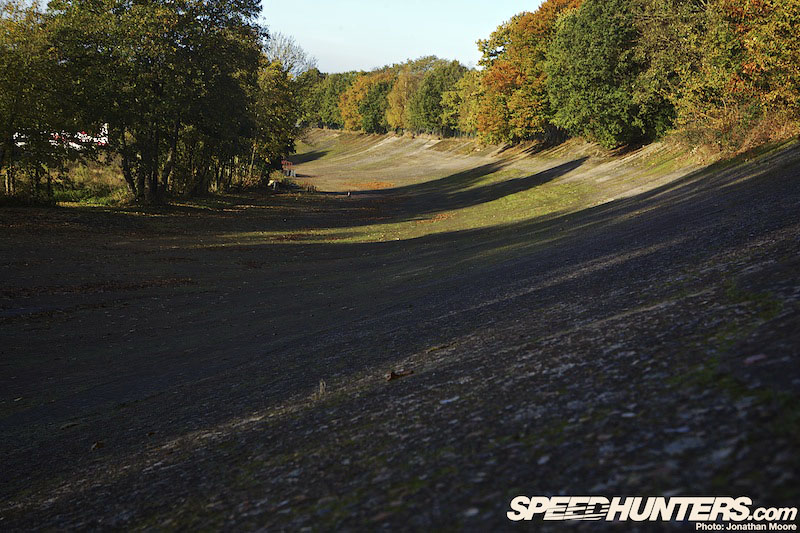
The sinuous twist of the banking continues in a constant radius, but drops slightly as reaches out towards the river crossing. As if the general concept of racing around here in period machinery wasn’t frightening enough, how about the lack of a fence at the top of the banking?
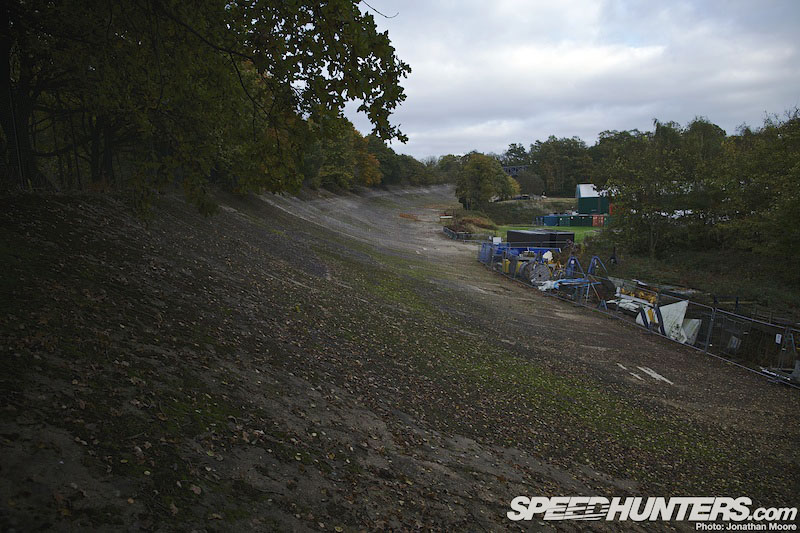
The section managed by the Brooklands Museum ends abruptly at the River Wey intersection, where the track was severed during WWII. Clambering to the top of the concrete gives an astounding view back up the track. Walking the Members Banking is an experience in itself: but most people don’t realise that so much more of the oval is still there to see.
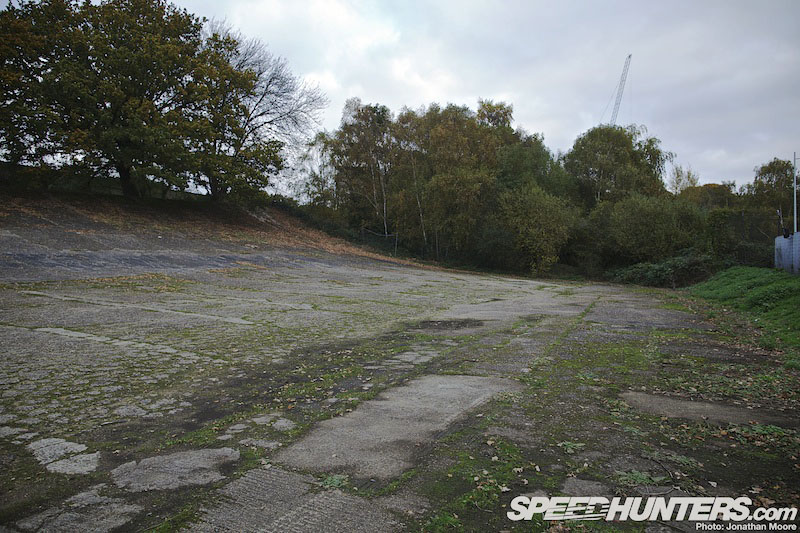
Mercedes-Benz now own the next section of track – it’s not open to the public, but can be visited as part of a driving experience or organised trip to Mercedes-Benz World. This is the other side of the River Wey, where the helical twist unwinds and the Railway Straight opens out. The surface is in particularly bad condition here, and worsens the further you go. That Mercedes use this section for off-road driving tells you something…
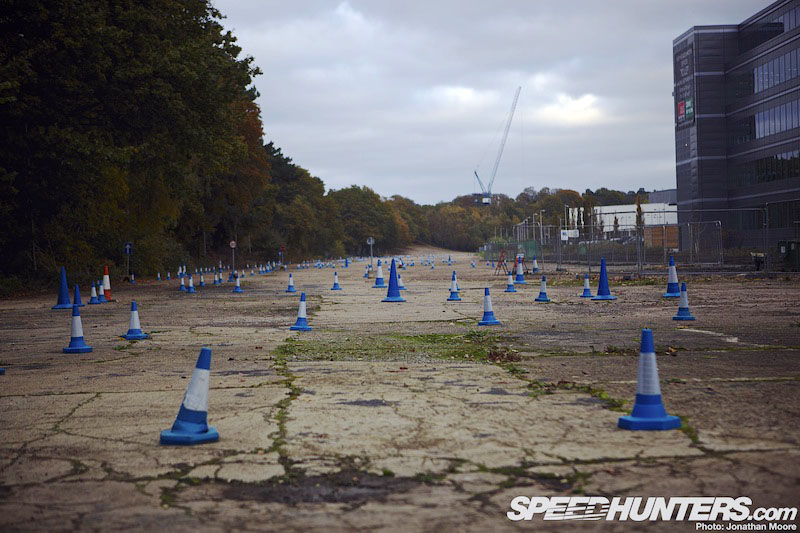
Looking back up the Railway Straight against the direction of racing, you can see that this part really was actually arrow-straight. The railway line runs on an embankment butting up against the right of the track (left in this image). It’s at about this point that the Campbell Circuit would have branched off to the right of shot at Railway Turn.
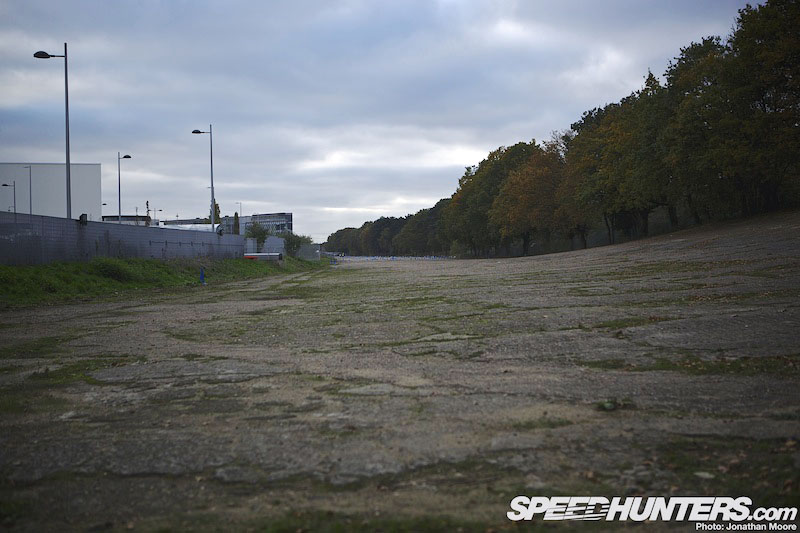
The Railway Straight just kept going into the distance. Now it ends in a fence and a construction site access crossing; the other side is owned by the big supermarket that nestles in the south-western entrance to the Byfleet Banking, partially built over, with what’s left covered in vegetation, broken up and inaccessible.
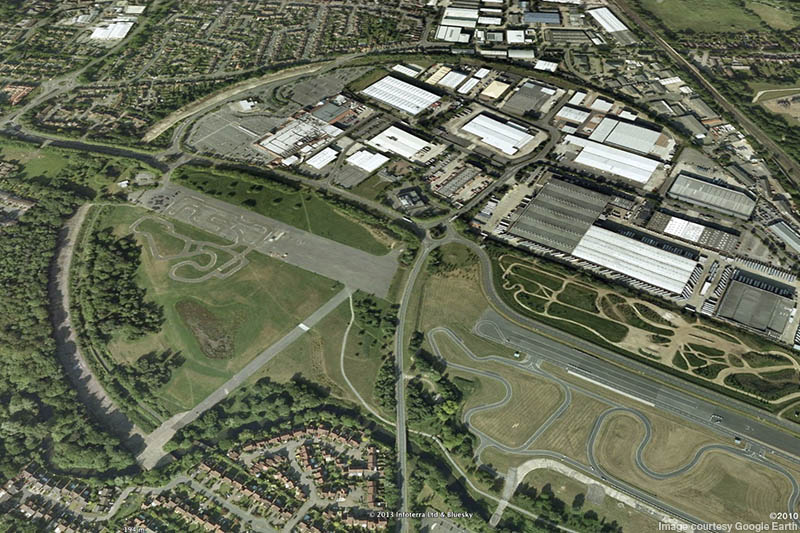
From an aerial view the breath-taking scale of the Byfleet Banking is much clearer. Brooklands is asymmetrical, egg-shaped really, with the tighter Members Banking at the north end balanced by the huge sweep at Byfleet. The diameter of the 180-degree Byfleet Banking is a massive 3,000 feet.
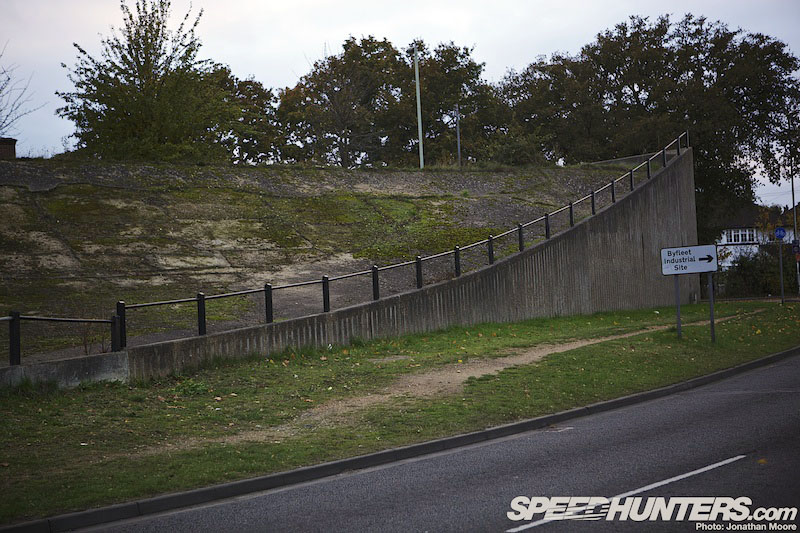
After a narrow diagonal slice through the track for an access road the Byfleet Banking picks up again. And it’s simply stunning.
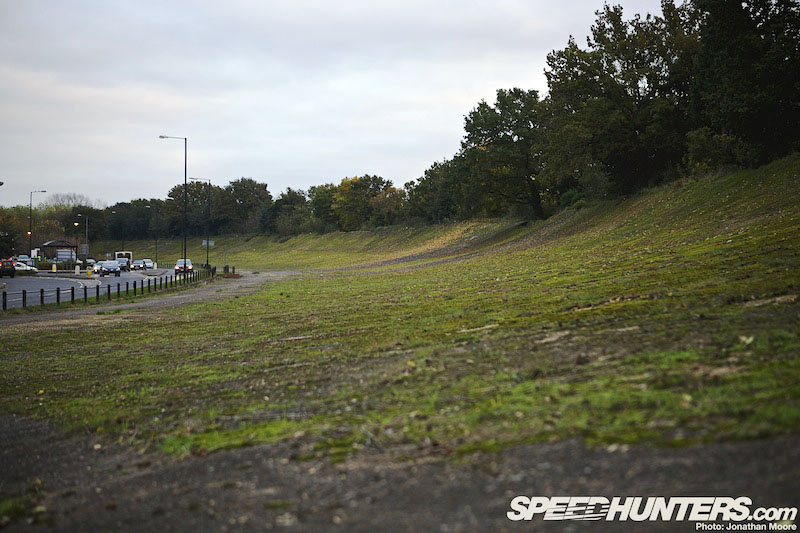
I hadn’t realised how intact this section was. Continuing the specified 100-feet width, it just stretches off into the distance, heeling over at a more gentle camber.
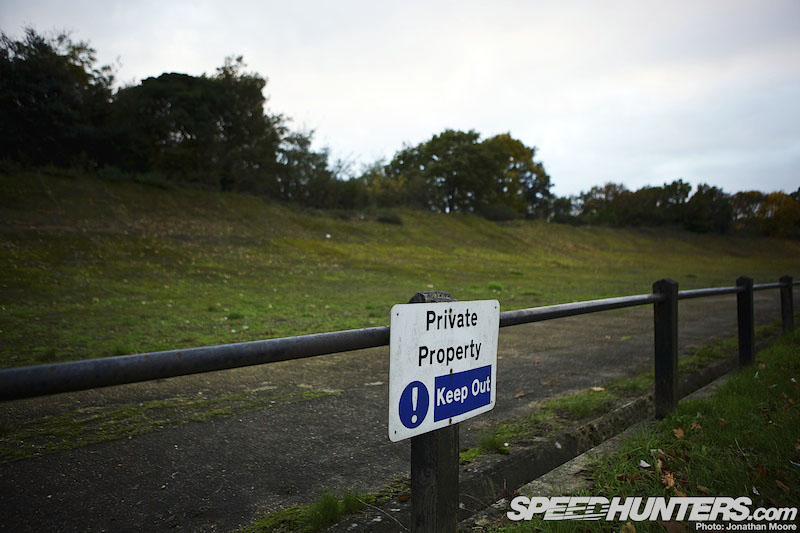
The low fence and Private Property signs subtly delineate the track from the public footpath: this section is also owned by the adjacent supermarket, who thankfully keep this part of their Brooklands territory visible and intact – if not directly accessible.
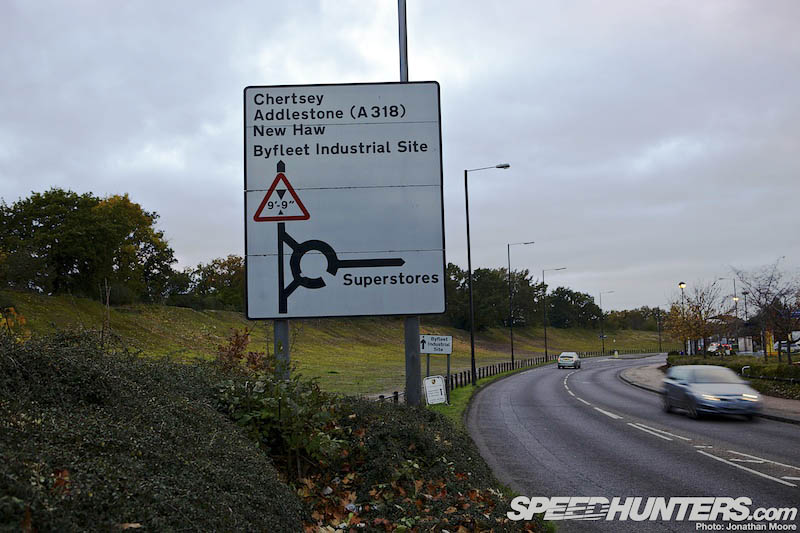
It makes you wonder how many people visit the supermarkets without a flicker of recognition for what the massive, mossy concrete wedge represents… As with the houses that back on to the Brands Hatch Grand Prix extension, this location would be enough to make me move to the area!
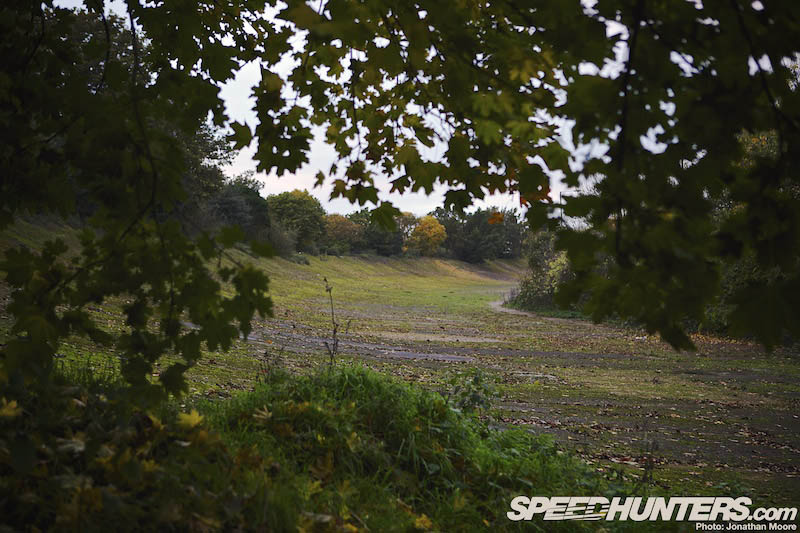
At about two-thirds of the way around the outer radius the track is again scythed through by an access road, this time much wider to cater for unexpected problems when taking the jets of the ’50s and ’60s on their test-fights. In the aerial shot further up you can see the wide strip of runway leading up to this point.
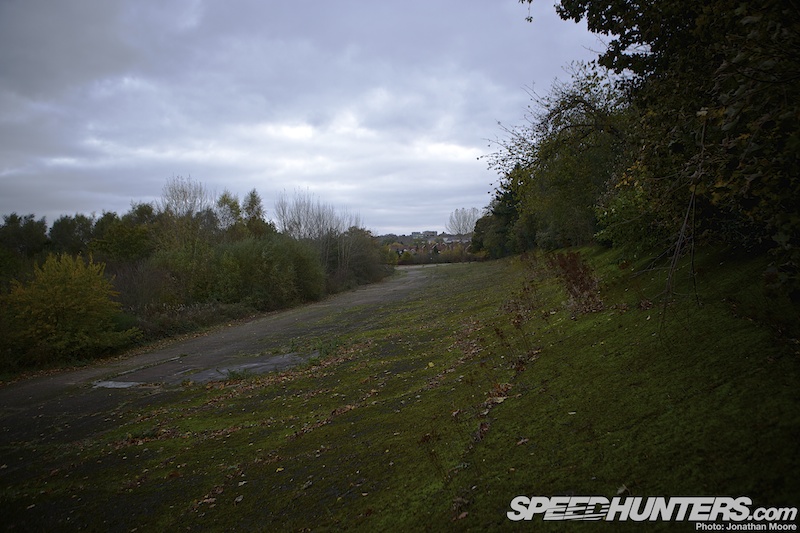
But on the other side – bliss. The Byfleet Banking continues on into the distance for the final 30 degrees of turn, and this is all public land. A large park sits on the infield; dog-walkers ambled past and mountain-bikers cycled on as I continued my gentle, contented stroll in the fading light.
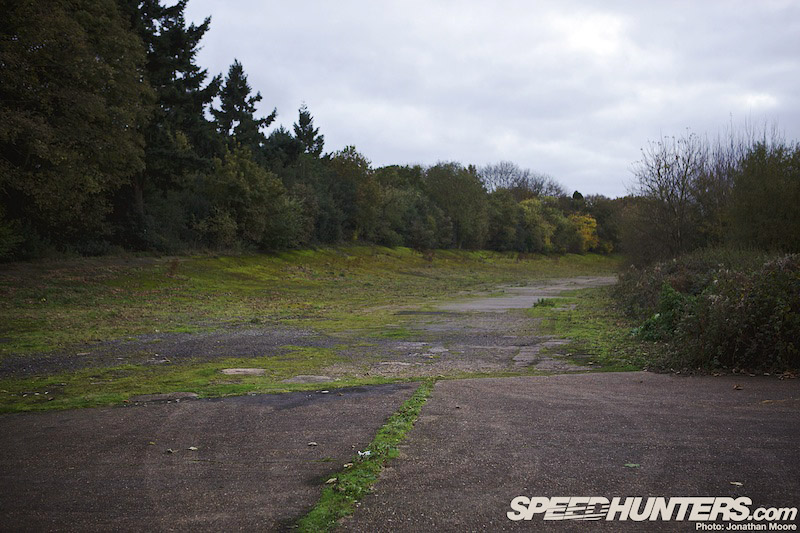
The banking – and the remains of the track – end at the final obstacle: the other crossing point of the River Wey. The concrete slab-section bridge section is the last navigable part of the circuit before it comes to an abrupt end, the concrete crumbling along the edge its mutilated cut before a short stretch of muddy grass and a fence.
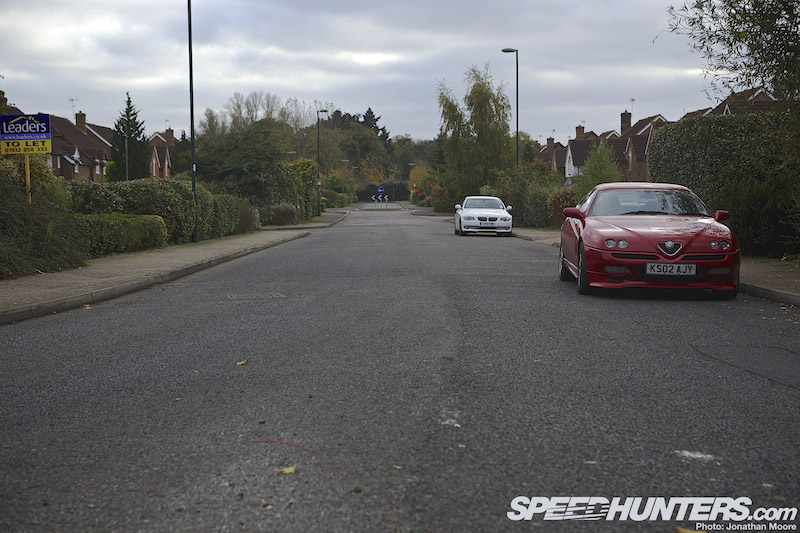
On the other side is a small housing estate. Only the names of the side-roads (Connaught Drive, Mays Close and so on) give clues to the ground on which these houses stand and the fact that their access road was once a wide stretch of circuit alive with racing cars. Coming towards us, racers would either head straight on down the finish straight or branch off right at the Fork. And there you have it: on a good day you really can experience several miles of the original Brooklands track.
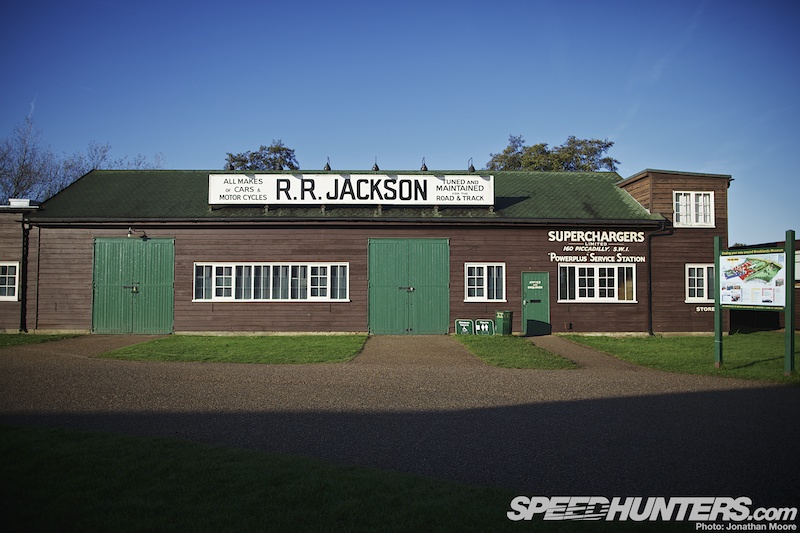
Over the subsequent decades more and more restoration work has been completed and the remaining track listed as a protected monument. In the last 10 years huge strides have been made, with the Brooklands Museum expansion and restoration of all the buildings and WWII hangars.
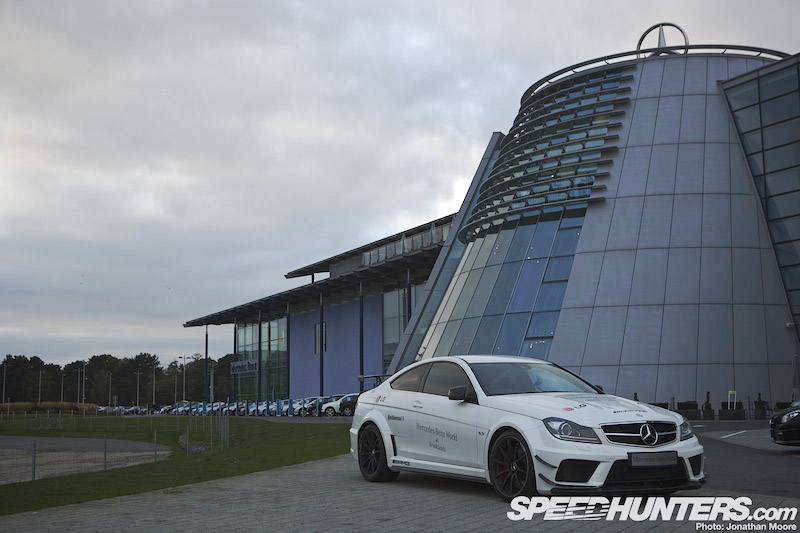
The most positive thing is that Brooklands thrives not just through its heritage but also has a new lease of life in the shape of the many automotive events that are held at the Museum site and the construction of Mercedes-Benz World next door, right on the perimeter of the old Campbell Circuit.
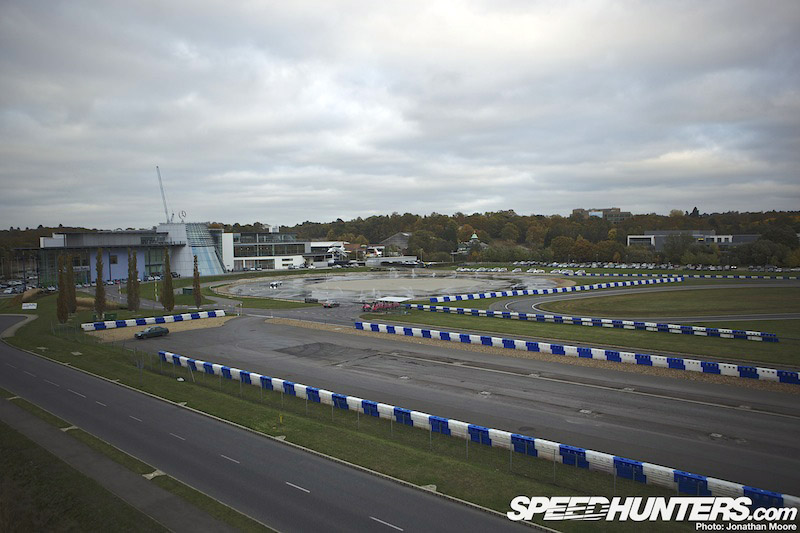
Mercedes’ financial and emotional investment (they raced here in the ’30s) has helped secure the future of Brooklands and raised awareness of this most impressive of motor racing venues. A visit to Brooklands is made even more special for the sound of thundering AMGs pounding round their test track. It just sounds right, and makes the old oval feel alive.
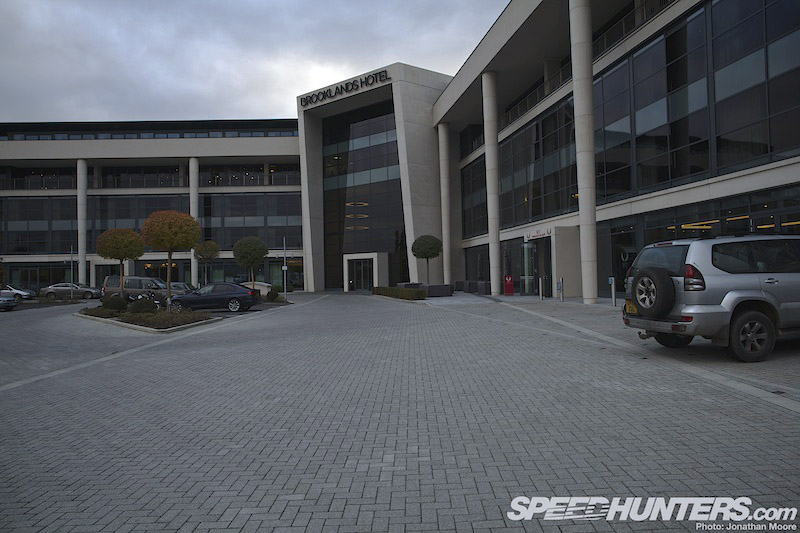
A luxurious spa hotel complex sits opposite Mercedes-Benz World, astride the original Solomon Straight of the Campbell Circuit. The Straight is defined by the lines of bricks on the approach to the reception…
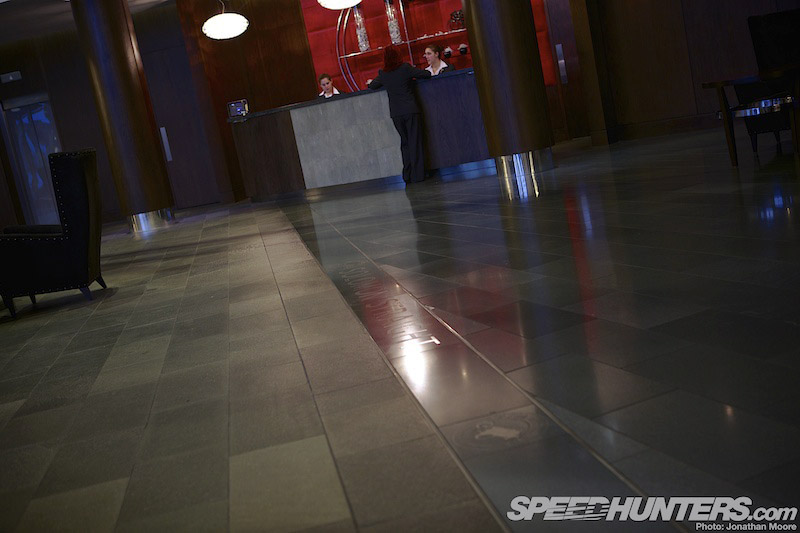
…which then continue right through the doors and into the lobby – it would have met the the Outer Circuit’s Railway Straight just fifty yards further on.
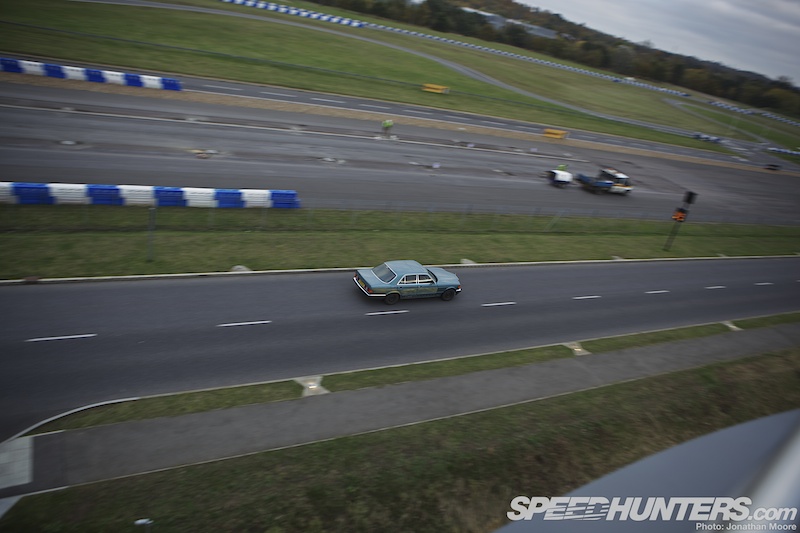
From the hotel’s spa balcony you can watch action on the M-B World track, which sits inside further remnants of the Campbell Circuit – and if you’re lucky it will be while wearing your dressing gown and with a nice glass of wine in hand.
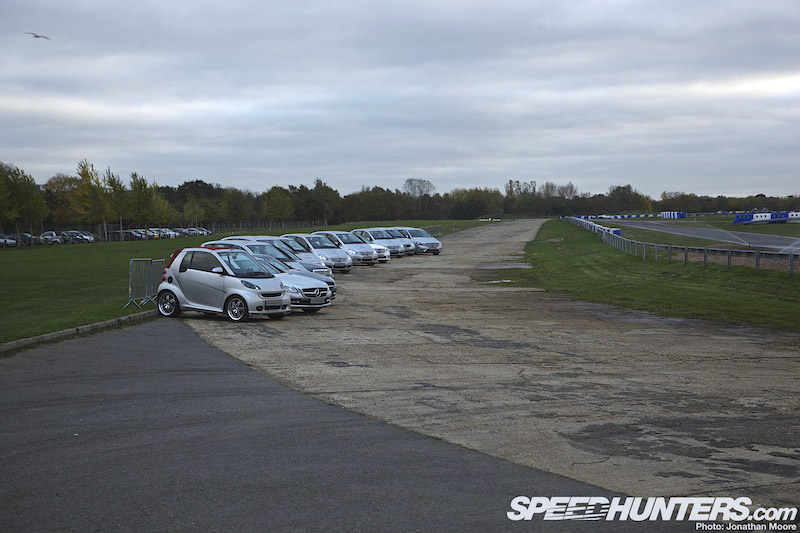
The battered concrete of the Sahara Straight is still used for access onto the modern Mercedes test track, and the small bridge built to carry the Campbell Circuit across the River Wey also still stands.
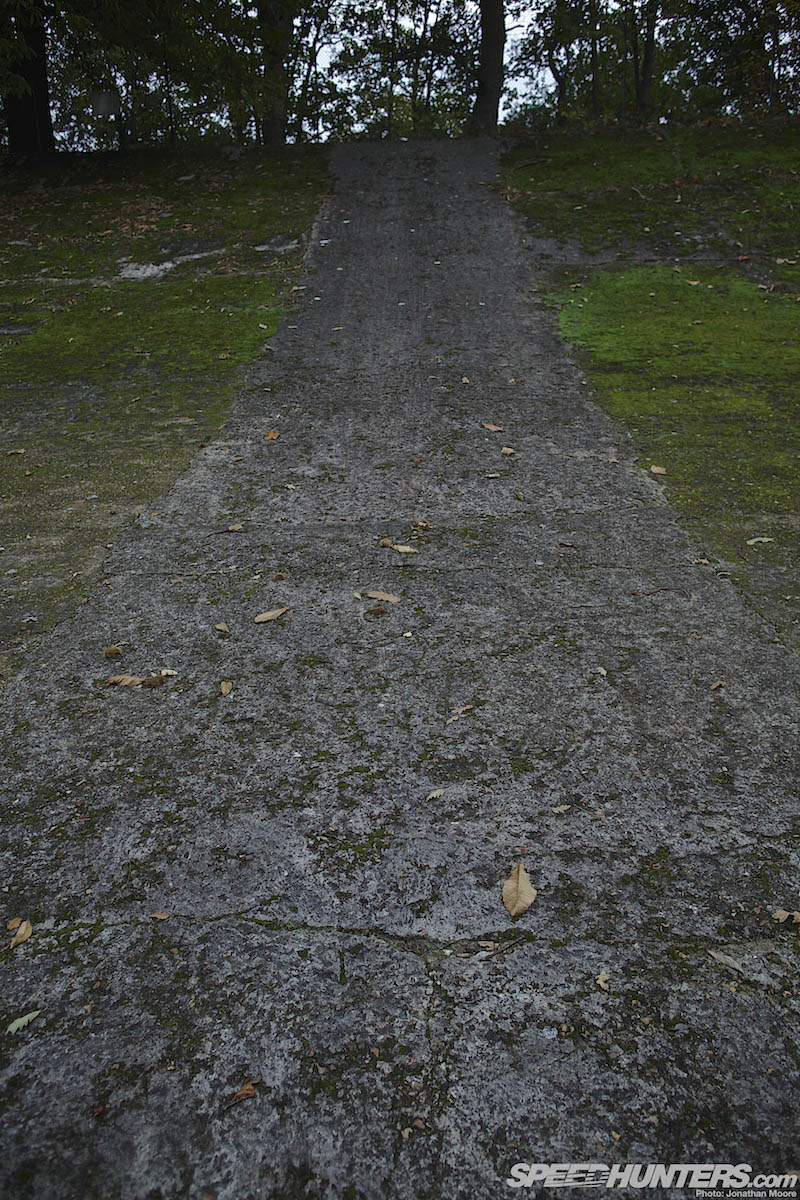
Brooklands is a magical place. Like at Monza, it’s easy to get carried away with the history and achievements that the track has played host to. The Museum and Members Banking are open all year round except over Christmas, but an option is to actually own a piece of the banking itself. This is possible via the Banking On Brooklands scheme, organised by the Museum to help raise funds for further restoration projects. Just think: you could own a square yard of one of the most significant racing tracks on the planet.
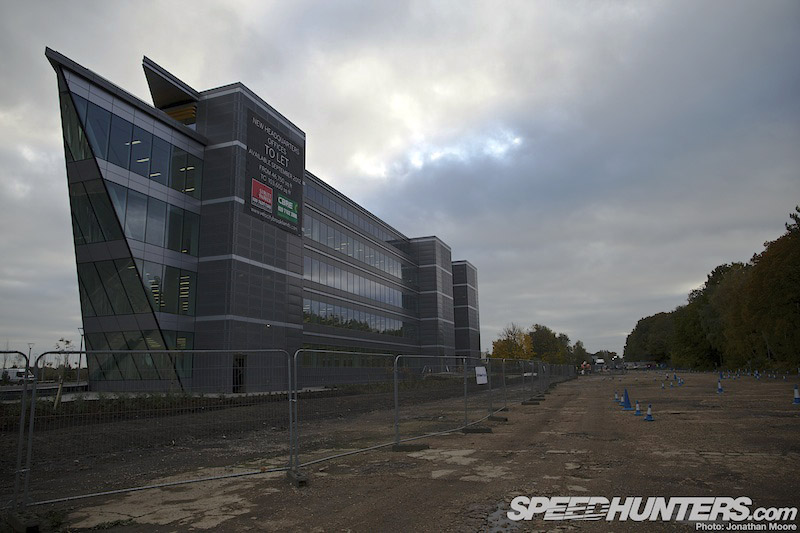
So for all my initial cries for a return to the past, in actual fact Brooklands is benefitting enormously from the modern era and is revelling in a new lease of life. Its relevance is better appreciated now than it has been for decades; the expanding Museum is bursting with exhibits (which will be the focus of my next story); and you can even enjoy a major part of the track for free on the way to the shops. What will the next century hold in store for Brooklands?
Jonathan Moore
More Temple Of Speed stories on Speedhunters















James May did a recreation of Brooklands with Scalextric in one of his tv programs. Really awesome
http://www.youtube.com/watch?v=dH06kqg--8U
Ken Block should do his next video here
Brilliant to see/read. I was born in Byfleet, lived in Weymede until aged 19 when moved to Australia, use to play on the embankments, and all before a it was publicly accessible land, supermarkets and recreation areas. No wonder I became a motor-racing fan/car nut.
Great post! I think it's a good thing that these stories are here on Speedhunters. I enjoy reading them maybe the most. To learn something about tracks is important if you are a true car enthusiast. Especially when there is so much history involved. Keep this kind of stories coming!
Great post! I think it's a good thing that these stories are here on Speedhunters. I enjoy reading them maybe the most. To learn something about tracks is important if you are a true car enthusiast. Especially when there is so much history involved. Keep this kind of stories coming!
Great post! I think it's a good thing that these stories are here on Speedhunters. I enjoy reading them maybe the most. To learn something about tracks is important if you are a true car enthusiast. Especially when there is so much history involved. Keep this kind of stories coming!
@Jochem I totally agree on that, keep these stories coming ! And the photos, like the post about Monza, are just marvelous !
They're just photos of an empty course, no race, no cars, but in a strange way, you have the feeling you hear them roaring...
@Jochem I totally agree on that, keep these stories coming ! And the photos, like the post about Monza, are just marvelous !
They're just photos of an empty course, no race, no cars, but in a strange way, you have the feeling you hear them roaring...
@Jochem I totally agree on that, keep these stories coming ! And the photos, like the post about Monza, are just marvelous !
They're just photos of an empty course, no race, no cars, but in a strange way, you have the feeling you hear them roaring...
Great article on motorsport history! I loved it! Way to keep the diversity!
Nice to see in the last picture, the "new headquarters offices" are still "to let"!
Thank you for this post Mr. Moore...
Awesome story! Great pictures and research, I feel like I'm there looking at the banking myself. More stories like this please!
Stunning article! You can almost hear them thundering round. A different time...
Stunning article! You can almost hear them thundering round. A different time...
Stunning article! You can almost hear them thundering round. A different time...
Stunning article! You can almost hear them thundering round. A different time...
Awesome story!
@roeby I think Speedhunters should move in there...
Great article. Thank you. This is literally history on my doorstep, I will try to appreciate it more.
Great article. Thank you. This is literally history on my doorstep, I will try to appreciate it more.
@Jonathan Moore Great idea, that would be loads more in tune with the history of Brooklands than say a laser photo copying company.
An absolutely brilliant read, i'll definitely be visiting!
Close the supermarkets alright. Phenomenal story and I do hope that all concerned do more to preserve the oval. Thanks again to Speedhunters for highlighting the old circuits.
Hi Jonathan, great article. I spent 4 years photograph the track at night (from a lot of the same angles as you have). Check them out if you get a chance. http://www.douglaskurn.com/brooklands
Cheers
Doug
thank you! great story my dad raced here on motorbike and sidecar , amazing what the guys did on that great old track